Key points
• Lighting: You need good lighting to make your Christmas food photos look festive and show off the dish’s colors and textures. Natural light works best for a cozy feel.
• Composition: Arrange your Christmas plates, ornaments, and cutlery nicely to make your photo look better. Use holiday props and the rule of thirds for balance and interest.
• Styling: To make the food in your Christmas pictures look yummy and festive, style it well. Pick the right dishes and decorations, add some garnishes, and stick to a color scheme that makes everything look great together.
Contents
- Key points
- Getting to Grips with Christmas Food Photography
- Key Points for Christmas Food Photography
- Why Looks Matter in Holiday Meal Photos
- Basics of Christmas Food Photography
- Basic Food Photography Tips
- The Role of Cultural Customs in Christmas Meal Display
- Leaders in Holiday Feast Photography
- Camera Tips for Stunning Christmas Feast Photos
- Simple Lighting Tricks for Christmas Food Photos
- Snapping Christmas Dinner
- How to Style Christmas Food Photos
- Playing with Colors for Holiday Vibes
- Getting Colors Right in Christmas Food Photos
- Tips for Great Close-Up Food Photography
- Using Depth of Field to Highlight Food Textures
- Using Props and Backgrounds in Christmas Food Photography
- Getting to Grips with Christmas Food Photography
- How to Keep Edited Food Photos Looking Natural
- Keeping Christmas Dishes Real After Editing
- Cultural Importance of Christmas Eats
- Regional Twists on Christmas Food in Pictures
- The Importance of Culture in Christmas Food Photos
- How to Take Photos of Christmas Food
- Building a Festive Food Photography Portfolio
- Networking and Collaboration Strategies
Getting to Grips with Christmas Food Photography
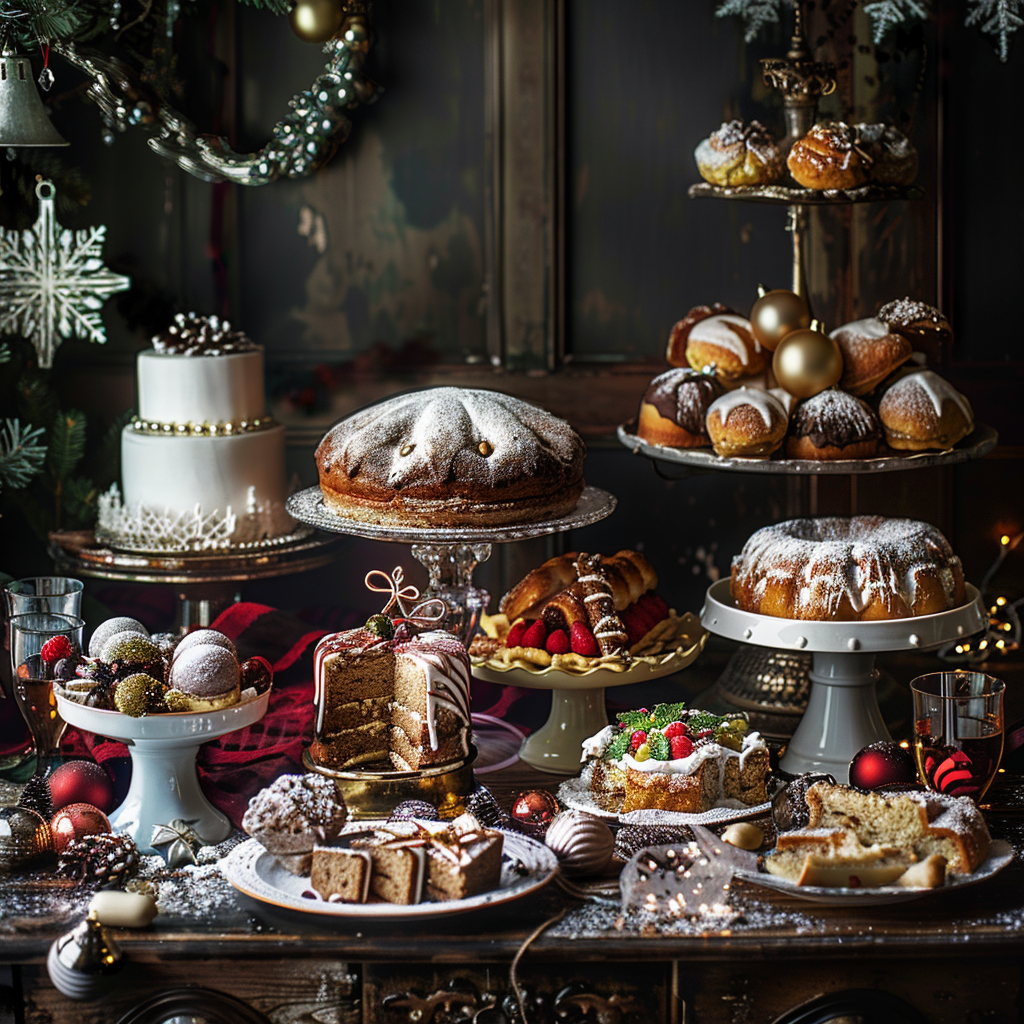
To master Christmas food photography, you need to know not just the basics of good photography, but also what makes the holiday season special. This type of photography involves mixing classic photography techniques with the feeling of Christmas warmth and happiness. You’re not only taking photos of festive meals—you’re trying to capture images that share the comforting, joyful vibe of the holidays.
Key Points for Christmas Food Photography
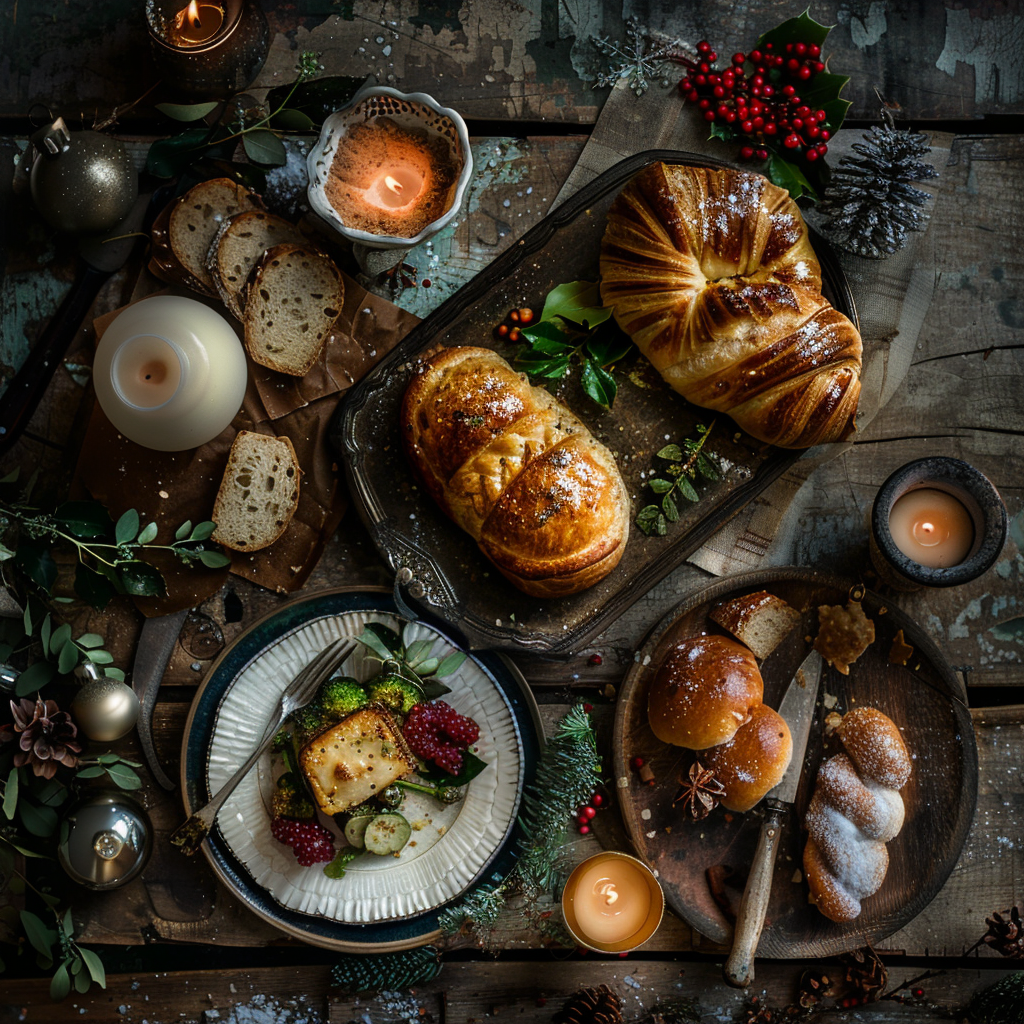
Getting into Christmas food photography means paying attention to some important details. You’ll want to use colors like red, green, and gold and add things like sparkly lights and holiday decor to make your photos look the part. The food in the pictures should be traditional holiday fare, like roast turkey or gingerbread cookies, and it needs to look amazing. Capturing the true spirit of Christmas in these photos is what makes this type of photography special.
To do well in this area, remember that lighting is key—it should be soft to match the warm feel of holiday get-togethers. Choose props that add to the festive mood but don’t take the spotlight off the food. When you’re editing, a few small touches can make the pictures shine without losing that genuine Christmas vibe.
All things considered, being great at Christmas food photography isn’t just about how good you are with a camera. It’s more about creating an image that brings out the joy, traditions, and tasty treats of the festive season for everyone to enjoy.
Why Looks Matter in Holiday Meal Photos
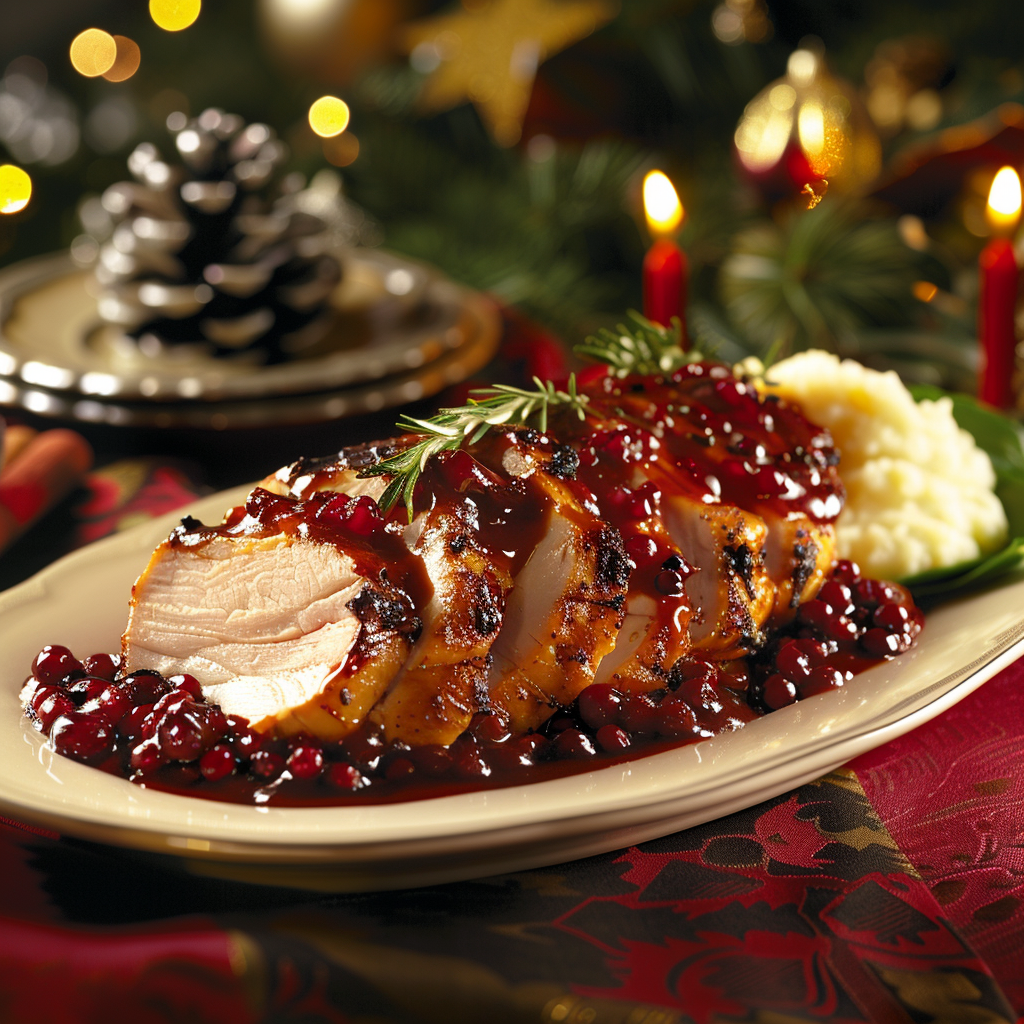
Pretty pictures do a lot for holiday food. They can make an ordinary meal look amazing and build excitement while making everything feel more festive. Good looks in food photos really matter because they show off the happiness, comfort, and generosity of holiday eating. When you add beauty to your food, you’re doing more than just feeding people; you’re sharing culture, keeping traditions alive, and showing your creativity.
The Impact of Good Looks on Holiday Food Display
Nice-looking holiday dishes are key in getting that party vibe right. The way you play with colours, set your dishes, and style your table tells a story about the holiday. If you throw in some seasonal decorations or use a theme, you give your food extra meaning that fits with the holiday spirit. Pretty food isn’t just pretty – it makes us look forward to eating and helps us remember all the tasty treats from our celebrations.
Basics of Christmas Food Photography
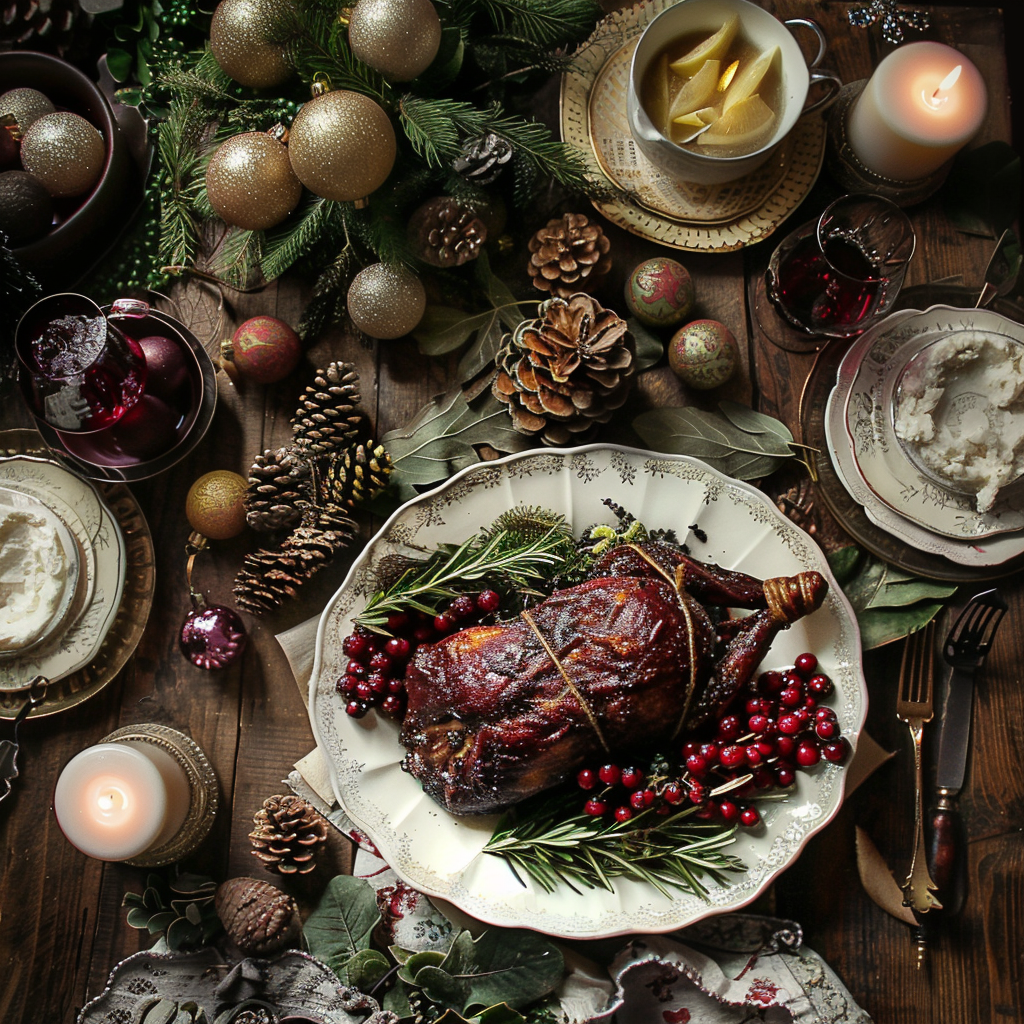
Taking great pictures of Christmas food needs more than just good timing. It’s about knowing the rules of food photography and tweaking them to fit the holiday vibe. You want to show off classic meals in a way that brings out feelings of coziness, plenty, and festive cheer.
Basic Food Photography Tips
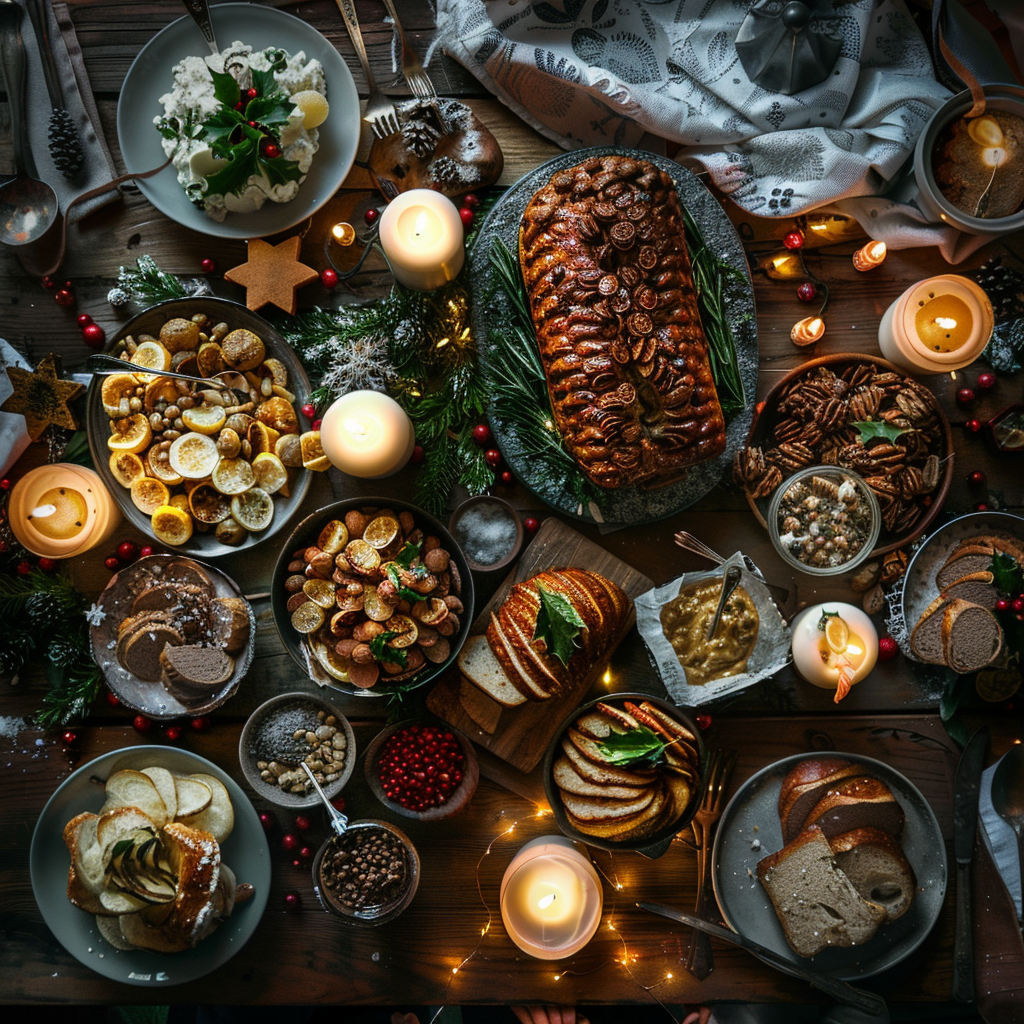
First things first, getting the lighting right is key. Use natural light to make the food’s textures and colors pop. Composition is about arranging everything in the shot to tell a story or highlight the main feature of the dish. The depth of field is all about how much of your photo is crisp – it helps focus on the food. Using selective focus can show off little details like sugar sparkles on a pie or butter shining on hot rolls.
Tailoring Techniques for Christmas Treats
Using holiday-themed props can really set the mood. Imagine pine cones, candles, and fairy lights to get that warm Christmas vibe going. Color matters too; reds and greens are classic Christmas hues that add to the theme. Also, don’t overlook textures like those from tablecloths – they add depth to your pictures and tie them into the holiday season.
Capturing Holiday Dishes with a Festive Spin
Paying attention to balance and symmetry makes your main dish stand out. Leading lines, say from cutlery or decorations, can pull people’s eyes through the picture. Don’t ignore angles either – an overhead shot shows off a full table, while zooming in can tease out mouth-watering details.
The goal is to evoke holiday nostalgia with every snap of the camera. So grab your camera, sprinkle some Christmas magic into your setup, and snap shots that’ll make folks want to dive in for a bite.
The History and Evolution of Holiday Food Pics
Images of festive feasting go way back, with paintings initially capturing these events. Then came photography, changing everything. Early photos of Christmas foods came around in the late 1800s and early 1900s. They were typically black and white and more useful than pretty, used in things like cookbooks or ads.
Post-WWII prosperity changed all that. Suddenly, holiday food pics were full of color and flair, reflecting the spirit of the season with warmth and family vibes. Magazines became key players, with December editions full of glossy images that influenced readers’ holiday dishes.
The rise of digital and social media gave food photography a new platform, focusing not just on finished dishes but also on cooking and partying, capturing the festive fun.
Nowadays, holiday food photos come in all styles, from professional magazine spreads to casual social media posts. They mirror both tradition and current styles. With today’s tech, anyone can snap a pic of their holiday spread. But even with all these changes, the heart of holiday food photography stays the same: it’s all about sharing the joy, togetherness, and generosity of Christmas time.
The Role of Cultural Customs in Christmas Meal Display
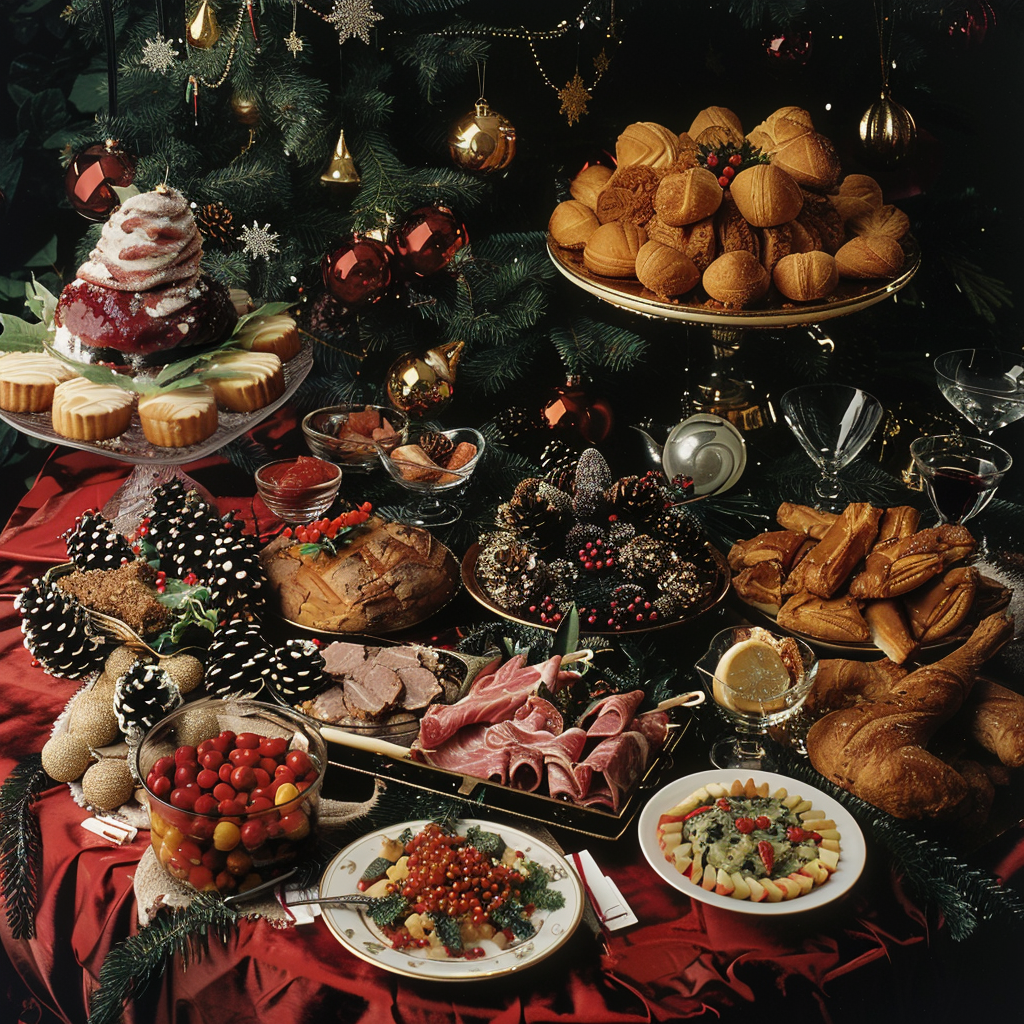
Cultural customs are essential when we celebrate Christmas, especially in how we present our food. The look of the dishes we serve during the holidays has a lot to do with traditions passed down through generations. This creates a rich mix of food that tells the story of different Christmas practices. Each part of the Christmas dinner, from the main roasted dish to the way sides are decorated, carries deep meanings and history.
How we show off our food at Christmas can be seen as an art that’s been shaped by long-standing traditions and social values. Take, for example, European-style Christmas dining, where every portion is carefully measured, and everything is neatly arranged. On the other hand, some cultures focus on showing generosity and the importance of family by offering plenty of food for everyone to share.
Certain ingredients in a Christmas meal even carry their own symbols in various places. Some spices are a must-have because they remind us of warmth and the festive mood. Their flavors and smells play a big role in making the celebration feel genuine.
How we decorate for Christmas also changes how we present our food. We use garnishes and set our tables to match cultural themes, blending cooking skills with holiday looks. The choice of colors for dishes and tablecloths can also connect us to different traditions, using visuals to tell the story of Christmas.
In the end, every part of how we set up our Christmas meal—from picking the dishes to arranging the table—is a nod to our rich culture. Our holiday tables give us more than just food; they’re like paintings showing the spirit of our cultures and inviting everyone not only to eat but to share in a meaningful group event.
Photographs of Christmas meals captivate people with sights that showcase holiday foods at their best. These pictures grab hold of the festivity and happiness of the season, highlighting all the lively colors and wonderful textures of what’s on offer. This type of photography does more than show pictures; it shares tales of family times and cultural customs. Whether it’s a roast turkey shining with its glaze or a gingerbread house with detailed icing, these photos turn holiday meals into a visual banquet.
Leaders in Holiday Feast Photography
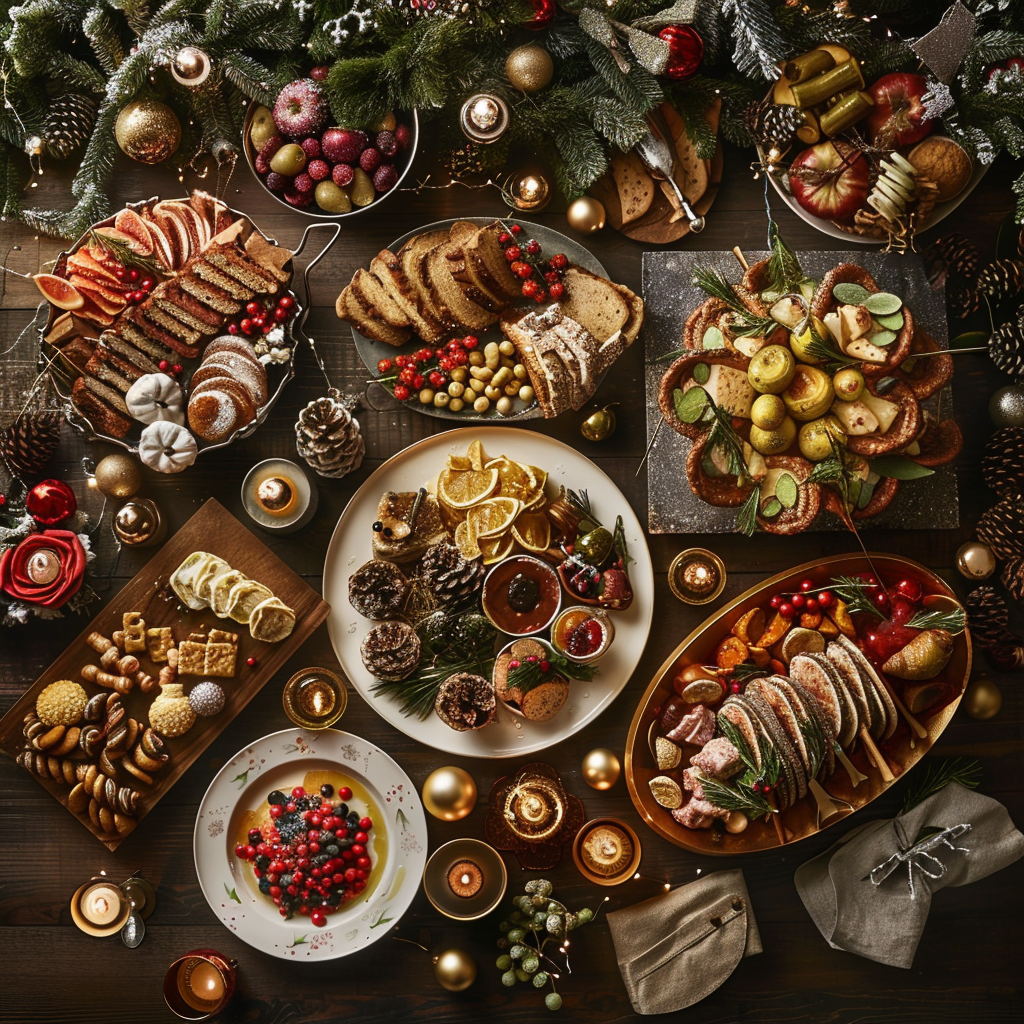
Some photographers lead the pack in Christmas food snapshots, setting the standard for others. They’ve crafted an art form of shooting festive meals, using light and layout to make each dish look tempting. Their influence shapes how today’s photographers approach holiday scenes, making sure they’re filled with cheer and enticing to the eye.
Spotlight on Standouts
These pros have honed their craft, finding the sweet spot between tasty-looking shots and real-life vibes. They may not be famous outside their field, but within it, they’re stars for the way they’ve shaped our visual taste. They capture the essence of holiday eating, stirring up joy and hunger in anyone who sees their pictures.
Taking snapshots of Christmas dinners is more than just pointing and clicking. It’s an art that fuses skill with the cozy feel of the holidays. Budding photographers should take a page from these pros. Learning from them and applying those insights means you can snap pics that are both mouth-watering and soaked in holiday spirit.
Camera Tips for Stunning Christmas Feast Photos
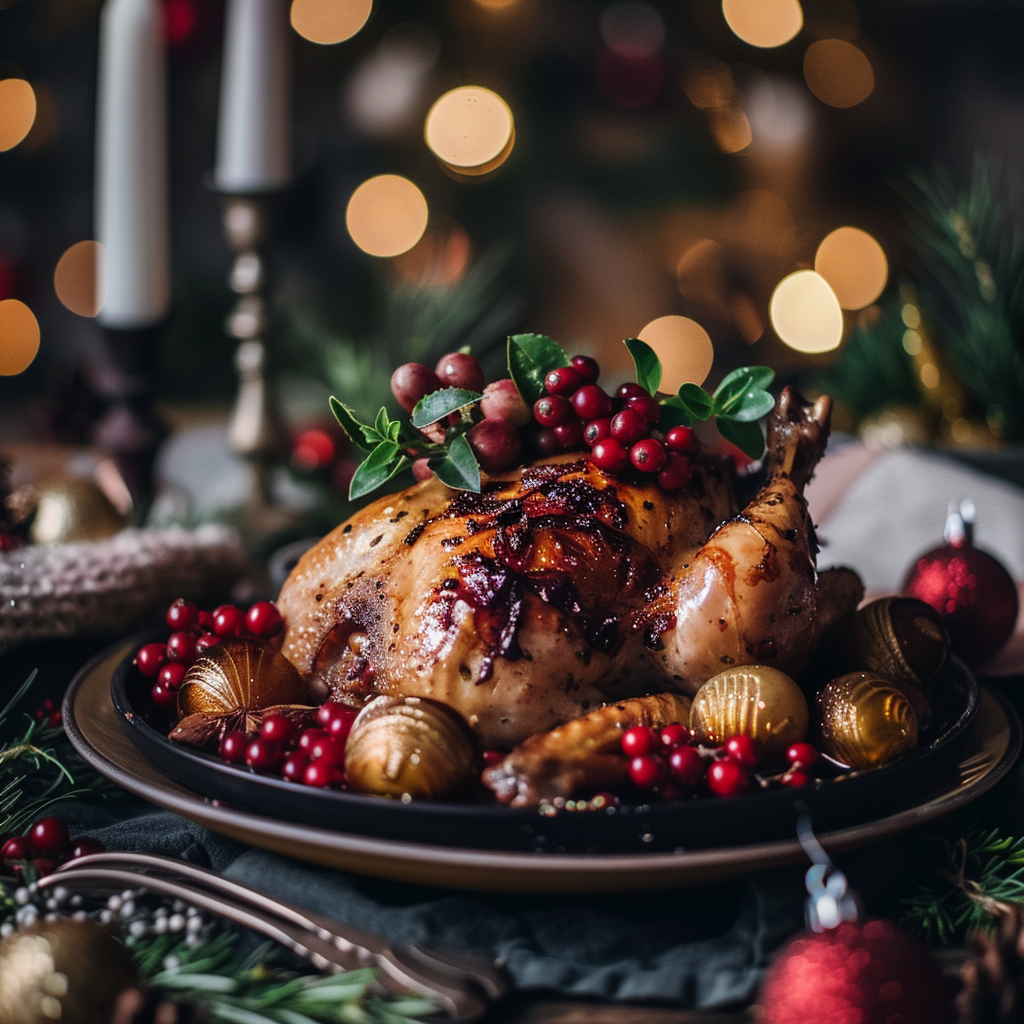
Capturing photos of your Christmas dinner is an excellent way to remember the holiday spirit. With a treasure of festive hues and textures across the table, it’s important to have the correct camera adjustments and tools. These ensure your feast looks as good in pictures as it does on your plate. Here’s what you need to know about capturing those tasty scenes.
Get to Know Your Camera
Understanding your camera is fundamental. If you’re shooting with a DSLR or a smartphone, get a handle on the manual settings when you can. Adjusting the ISO, shutter speed, and aperture is essential. They help control the light and how much of your photo is sharp.
The Right Lens is Key
Selecting the right lens is vital for high-quality pictures. A macro lens allows you to get up close and personal with those scrumptious details. You could also use a standard 50mm lens; it’s versatile and avoids warping your images.
Keeping Your Camera Still
Sometimes, photos turn out blurry; other times, they’re crystal-clear. The secret? Stability. A tripod can keep your camera steady, which is super important for those dimly lit Christmas dinners.
The Importance of Lighting
Good lighting can transform a good picture into a great one. It brings out the best in colors and surfaces, making the food look irresistible. Natural light is ideal for its gentle quality, but if that’s not possible, consider using artificial lights. Something like a ring light or softbox can give you smooth, even lighting and minimize unwanted shadow.
Add Some Flair with Props
Your styling skills can really add to the overall effect of your photographs. Arrange some silverware, napkins, and other bits and pieces around your dish to craft that warm holiday feel. But be careful not to clutter—an overcrowded photo can take attention away from the star, which is your delicious meal.
Modes and Editing Matter Too
Don’t overlook the power of shooting modes and editing. Most cameras have preset modes for various types of shots, including food photography. These are especially handy for beginners. Once you’ve got your pictures, a little tweaking with editing tools can bring out the best in contrast, color, and detail. This gives your images that polished look that’s almost good enough to eat.
Simple Lighting Tricks for Christmas Food Photos
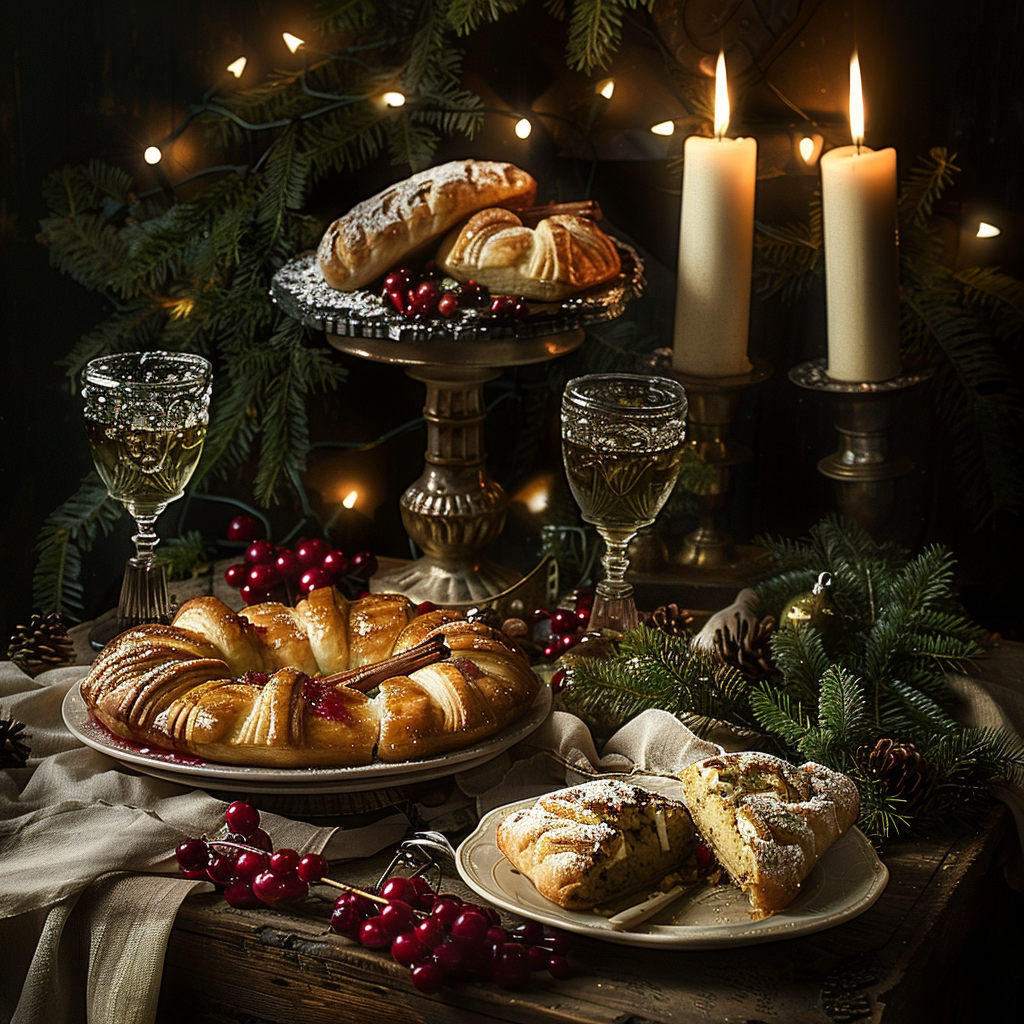
Taking great Christmas food photos involves knowing how to work with light. Proper lighting not only makes your food look good but also brings out that cozy holiday vibe.
Use Daylight for a Homey Feel
A winter afternoon’s light has a special quality. To catch this look, set up your food near a big window. The sunlight will come in softly and give your treats gentle shadows, making it look homey. If the light’s too strong, hang a thin curtain to soften it even more.
Catch the Golden Hour Shine
The golden hour is right after sunrise or just before sunset. It gives a nice warm light that feels nostalgic. But it doesn’t last long, so you’ve got to be quick to use it right.
Artificial Light When You Need It
If you can’t use natural light, artificial lights like lamps or flashes are your friends. You can direct them and change how bright they are. Use softboxes or umbrellas to spread the light out so it looks natural. Dimmable LEDs let you fine-tune the brightness for that perfect wintery look.
Add Sparkle with Fairy Lights
Fairy lights add charm and sparkle to your Christmas food shots. Wrap them around or behind the food to create depth and draw the eye. They can make your background blur into pretty points of light that really feel like the holidays when you use a wide lens aperture.
Candlelight for Coziness
Candles bring a cozy touch to your pictures. Place them carefully to shine on your dishes and make an inviting scene. Just be careful—they can throw off the colors of your food if they’re too bright.
Soften Shadows with Reflectors
Strong shadows might ruin the holiday mood, so use reflectors to fix them. They bounce light back onto dark parts of your food. You can buy professional ones or just use a piece of white cardboard to get the job done.
Snapping Christmas Dinner

When you’re taking pictures during Christmas, you’ve got to set up your shots to look nice and neat. The goal is to get people really into the picture and to make sure that yummy Christmas food is the star. Here are some tricks to nailing a great shot:
Cutting It into Thirds and Spotlights
You gotta use the rule of thirds; think of your shot split into nine even parts. By putting the important stuff where those lines cross, you make everything look well-balanced. Having your main dish smack in the middle can be pretty eye-catching too, putting the focus right where you want it.
Zigzags and Stacks
Use zigzagging lines to pull people’s gaze through the picture. Stacking up food and decorations gives your photo layers, which makes things pop out more. Stick the tall items in the back and the small ones up front so that each detail gets its chance to shine.
Colors and Feel Contrast
Throw in some bright colors against plain backgrounds or mix different feels like shiny glazes on dull plates or crunchy veggies next to smooth dips. Mixing it up keeps the picture interesting – think about combining shiny stuff with ones that aren’t so shiny, or leafy veggies near thick dips.
How to Style Christmas Food Photos
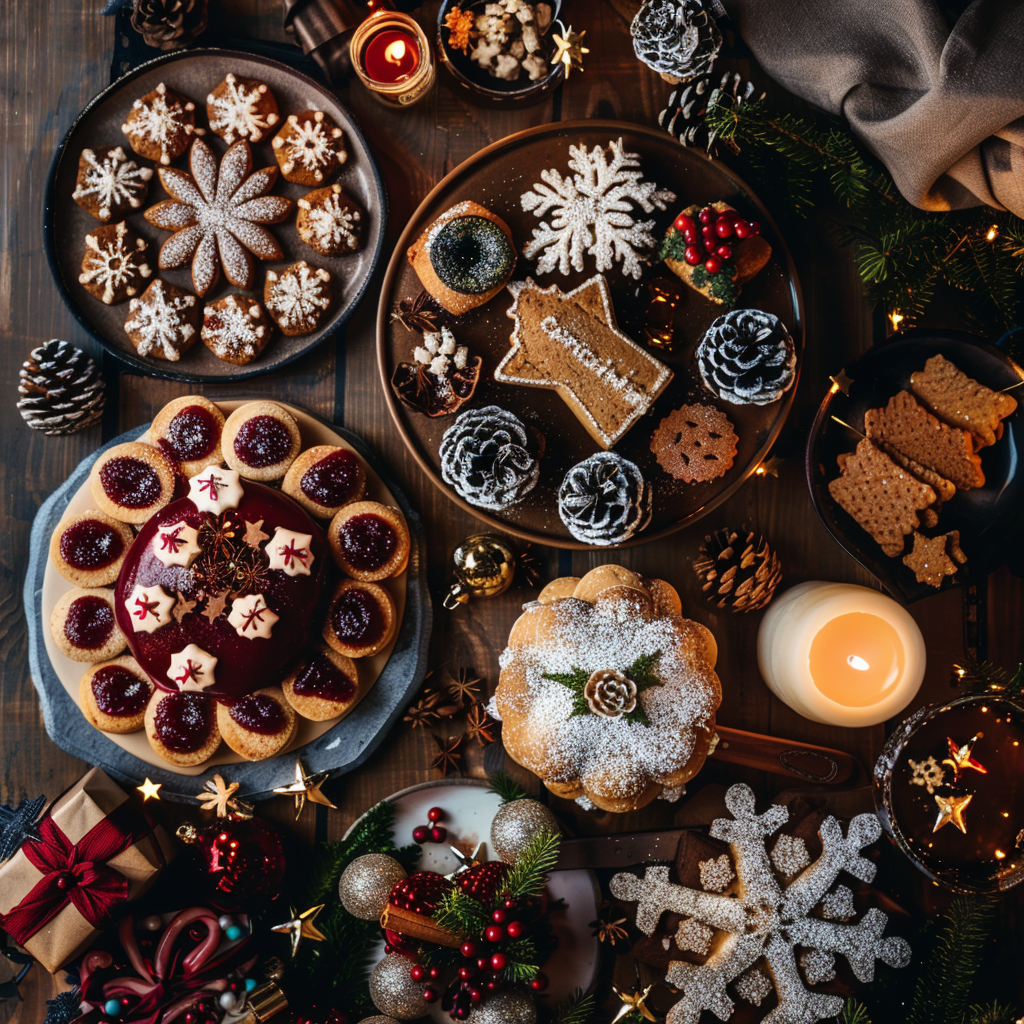
Making your food pictures look like Christmas can add to the holiday spirit. Focus on the small things to help tell a festive story in every photo.
Choosing Props and Decorations
Pick props that add to your dish, like pine cones, candles, and cranberries, but don’t let them take over. A touch of holly or some sugar that looks like snow can work magic.
Arranging Your Space
Don’t pack too much into one photo; it could end up looking messy. Arrange dishes and silverware with space between them, aiming for a balanced look.
Lighting and Reflections
Try to use natural light for your photos. It gives off a cozy vibe, just like Christmas with your family. Watch out for glare on shiny stuff and change your angle if you need to.
To MAKE your Christmas food pics special, you need to be both creative and know-how. The Way you put together your photo is how you make people feel like they are there, smelling and tasting the food. Ready your camera, put love into your styling, and take pictures that would even STOP Santa in his tracks. Don’t worry if everything’s not perfect—sometimes the best parts are unplanned.
Understanding colors is key when taking appetizing Christmas food shots. Colors set the mood and stir emotions which is super important during the holidays.
The Importance of Color Selection
The colors you choose can really influence what people feel when they look at your photos. For Christmas, folks typically use reds, greens, and golds because they’re all about holiday cheer. Picking colors that go well together makes this even stronger.
The Impact of Colors
Every color has its own meaning that works on us without us even realizing. Reds are intense and full of life and can make you hungry – great for Christmas dinners. Greens make us think of peace and new beginnings while whites bring purity and calmness, balancing out all the excitement of the holiday season.
Winning Color Combinations
To find the best colors, it helps to understand the color wheel and how colors relate to one another. Some ideas are:
- Complementary Pairs: Red and green are opposite each other on the color wheel, so they’re a natural match for that traditional Christmas feeling.
- Similar Colors: Different kinds of red—like burgundy or pink next to each other—look good together.
- One-Color Look: Using several shades of just one color can make your photos look stylish and united.
Lighting and Texture Contrast
Good lighting is needed to show off our colors as they really are. Generally, soft light is best for letting the colors shine through without being too bright. Mixing different textures changes how we see colors too; rough surfaces soak up light and smooth ones bounce it back, which adds depth to your picture.
Tips to Avoid Mistakes
Here are a few no-no’s to keep in mind:
- Stay away from super bright colors that don’t look real, unless you’re going for that.
- Dont use colors that clash because they can create an unsettling feeling instead of something nice.
- Pay attention to whether colors have a warm or cool feel make sure they fit the mood you’re going for, be it refreshing or snug.
In short, using color theory in your Christmas food photography can turn plain pictures into something enchanting. It’s about finding that sweet spot, waking up feelings, and making a photo that’s as pleasing as the actual feast it shows.
Playing with Colors for Holiday Vibes
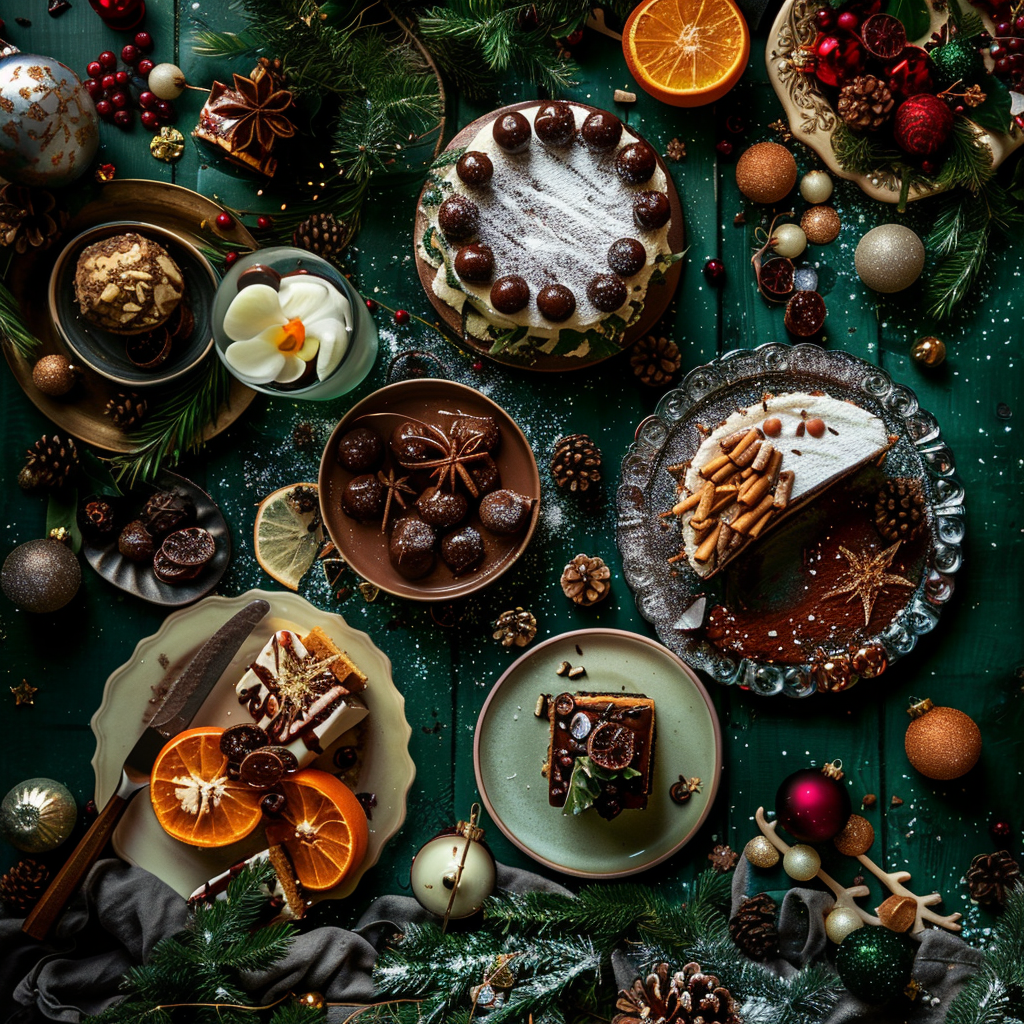
When you’re snapping photos of festive food, picking the perfect color mix is crucial to bring out that Christmas feel. Colors hit us right in the feels and can zip us right into holiday mode in no time.
The Basics of a Christmas Color Mix
A classic Christmas palette pulls a lot from nature and the typical yuletide decor. Knowing how colors work together helps you make pictures that stir up that cozy, nostalgic holiday feeling.
Christmas pictures are mostly reds and greens. But toss in some whites, golds, or silvers, and you’ve got yourself a contrast that pops. Throw in secondary shades like the toasty browns of pine cones or cinnamon, and your pics will ooze warmth.
How to Choose and Arrange
Pick your shot elements wisely to make an impact. Here’s what you can do:
- Bold Reds: A splash of red – maybe a ribbon or some berries – instantly screams Christmas joy.
- Evergreen Greens: Add some plants or tree bits for that fresh, alive feeling that says “Christmas tree” loud and clear.
- Pristine Whites: Bring in white touches, like sugar dust or fake snow, to give off those cozy winter vibes.
- Glints of Golds and Silvers: Metallic shine adds that holiday twinkle, just like Christmas lights or baubles.
It’s all about balance; too much of one shade can throw things off. You want the colors to guide the eye and share the Christmas story.
Bringing It Home
Getting a smooth color flow takes a sharp eye. Play with complementary colors – opposites on the color wheel – to amp up the wow factor. Reds with greens or golds with blues give a pleasing punch.
Don’t just stick to colors – mix up textures too. Combining shiny stuff with dull finishes keeps things interesting. It is the season of going all out, after all. You wanna show off Christmas in a burst of colors that draws people in and makes them crave those festive treats.
Keep it simple but catchy — craft a scene that nods to old traditions but also beckons folks to dive into the picture and enjoy the holiday goodies!
Getting Colors Right in Christmas Food Photos
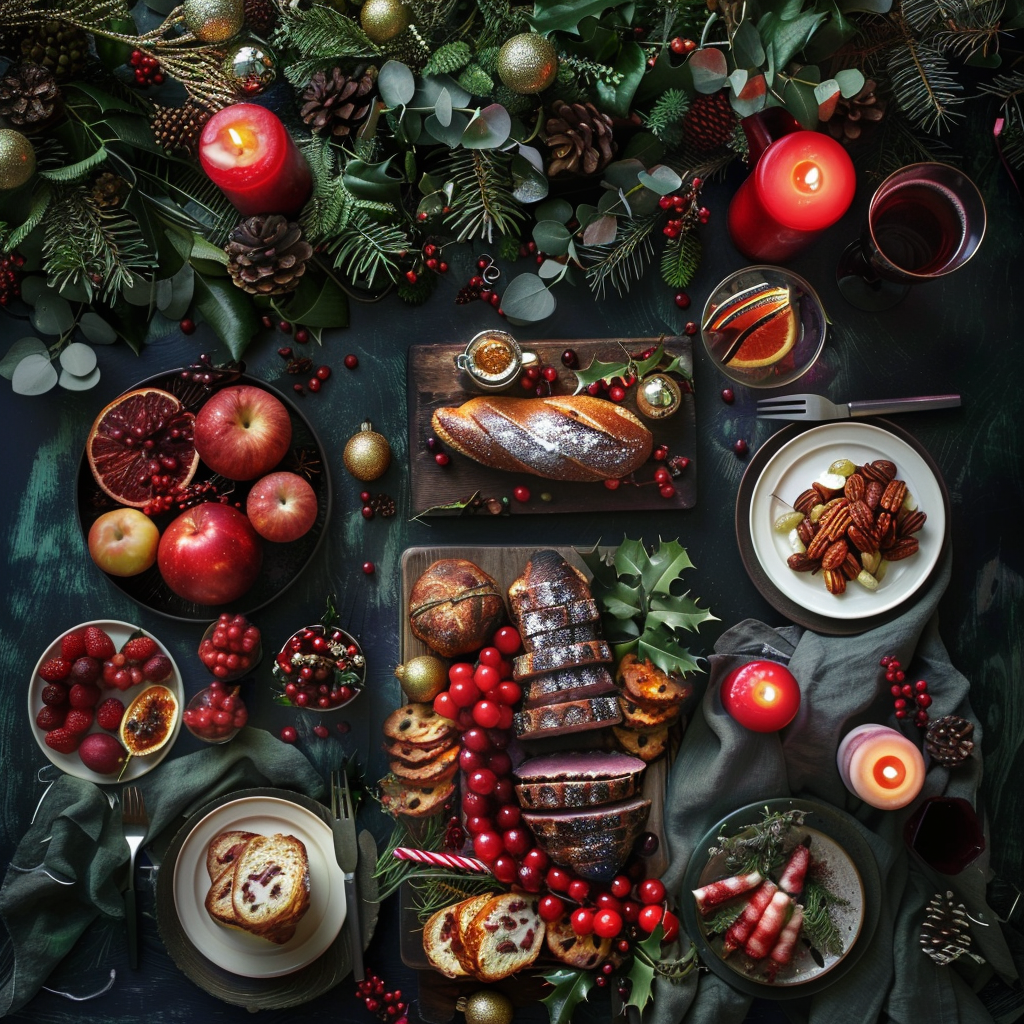
Capturing eye-catching images of Christmas dishes means knowing how to balance the colors. A good photo grabs attention and makes your food look tempting. It’s more than just how you arrange the food – it’s about choosing the right colors to bring out that holiday spirit. Ready to learn how to get the perfect color in your Christmas food photos? Let’s get started.
Color Theory Basics
Understanding color theory is essential for photography, especially with food. You’ve got those basic colors – red, blue, and yellow. When you mix those, you get secondary colors. Remember that colors across from each other on the wheel look great together. Take red and green – they’re classic for Christmas and create a striking balance.
Picking Your Color Palette
Choosing the right color palette takes some thought. What colors are in your dish? Reds and greens, or maybe some golden browns and creams? Choose backgrounds and accessories that compliment these colors without fighting them. A little contrast is great, but don’t over do it.
Props and Backgrounds Matter
Don’t underestimate the power of props and backgrounds. They set the scene. Think about a dark blue background with an orange glaze – nice, right? Or a wooden table for dishes like turkey or cookies, giving off a homey feel. It’s all about creating a vibe that screams “Christmas” without saying a word.
Natural vs Artificial Light
Lighting time! Natural light is usually best for food pics, because it gives a soft look. But sometimes artificial light can help highlight certain colors in your dish. Warm lights work well with warm colors, and cool lights can tone down bright ones – just don’t make your desserts look weird!
The Power of Editing
It’s OK if your photo isn’t perfect right away; that’s what editing tools are for. They can help fix things like saturation, contrast, and sharpness. Maybe punch up the reds in sauces or soften the yellows in pastries – just keep it looking real.
To sum up: To get noticed with your Christmas food pictures, the colors need to be spot-on. Whether it’s a family recipe or fancy dish, mixing the right features ensures your photos are as tasty-looking as they are delicious to eat. Follow these tips for photos that’ll get heaps of likes!
Paying attention to the small things, like textures in Christmas foods, can turn simple photos into something special. The variety of textures during the holidays is huge, from crunchy turkey skin to smooth eggnog. Getting these textures right really improves your photo’s impact.
Using Light and Shadow for Texture
Good use of light is crucial when it comes to showing off texture. Play around with light direction and strength to show off rough mince pies or delicate pastries. Side lighting often reveals textures by creating shadows and highlights. Natural light tends to be best for authentic, good-looking shots.
Capturing Details That Tell Stories
The little things in a dish reveal stories about family traditions or holiday inspirations. To highlight these, focus on composition and clarity. Zooming in on details brings them up front and center. Make sure your photos are sharp by using a tripod or a high aperture setting.
Your goal is to make photos that not only make people hungry but also give them the festive feeling of Christmas. A well-taken photo brings back memories and feelings and takes viewers straight to the holiday feast itself. By focusing on texture and detail, photographers can share all the taste and celebration that comes with the season.
Tips for Great Close-Up Food Photography
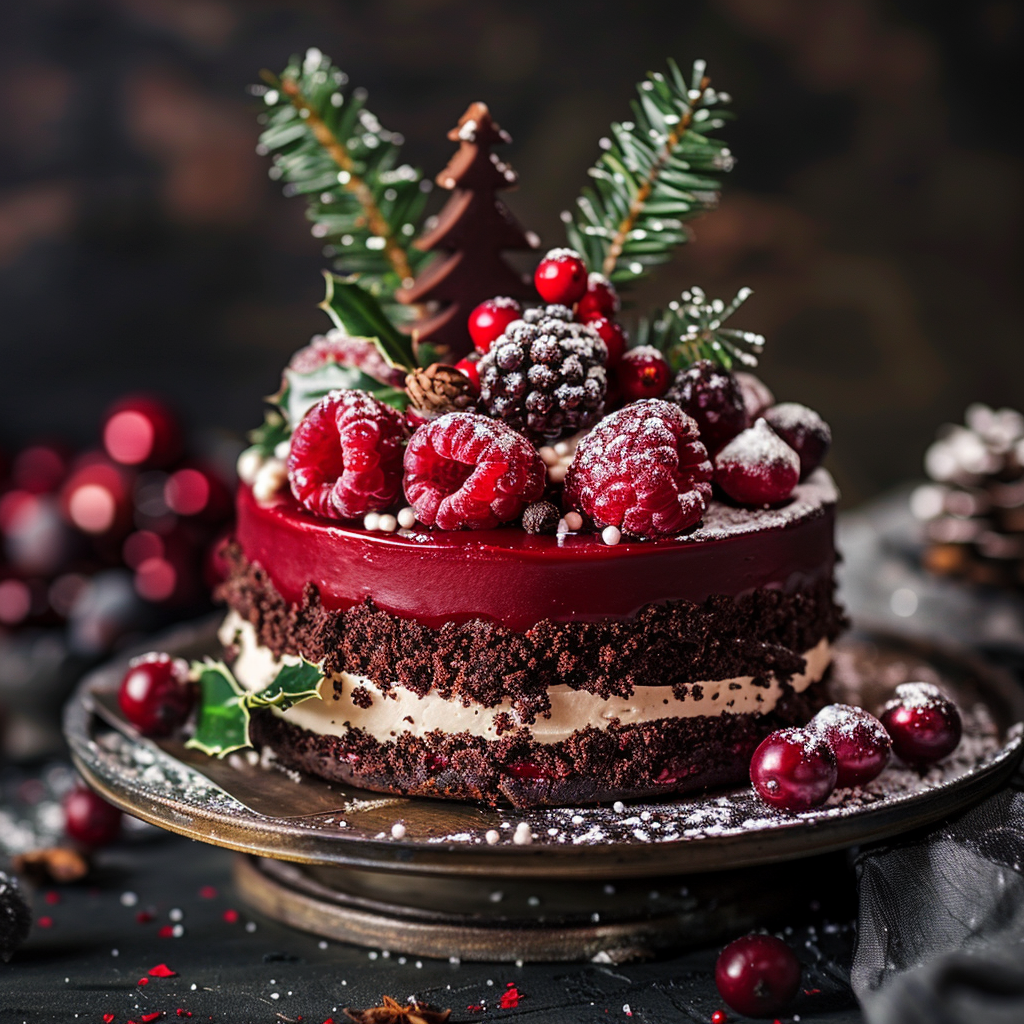
Getting better at close-up photography can really make your Christmas food pictures stand out. When you zoom in on the yummy details, you show off the textures and colors that make holiday foods look so tempting. This kind of photo lets people see small things that they usually miss, like a light sprinkle of icing sugar on a mince pie or the glossy glaze on a roast ham. Try these tips to focus on these tasty details and interest your audience.
Picking the Best Gear
Choosing the right equipment is key to getting those close shots of holiday dishes. A macro lens is perfect for close-up shots as it’s made for that purpose. A tripod helps keep your camera steady, which means you’ll get clear, sharp pictures without any blur from shaky hands. If you’re taking pictures without a tripod, make sure your camera has features to stop blurring or use a faster shutter speed to avoid shaky shots.
Getting the Lighting Right
You need good light to show off small details. Soft, diffused light is often the best choice because it shows textures without creating shadows that hide details. Trying different lighting angles can add depth to your photos with interesting shadows and highlights.
Arranging Your Shots
The way you set up your shot and the angle you choose can change how the picture turns out. For example, shooting from above can show off how your Christmas table is arranged, while snapping pictures from table height might make it feel like you’re sitting down to eat with everyone. You could also use the rule of thirds to move important parts of the photo off-center for a more exciting look.
Playing with Depth of Field
Depth of field is super important in close-up food photography. A shallow depth of field, which you get with a wider aperture, will make the background blurry so people only focus on the part of the food you want them to see. If you want to include more of the surroundings in your photo, go for a smaller aperture to keep everything in focus.
Editing Your Photos
Once you’ve taken your photos, editing them can bring out even more detail. Tweaking contrast, sharpness, and color levels can make those details stand out. Just be careful not to edit too much because it might make your photos look fake and less tasty.
In summary, close-up photos can really show how delicious your Christmas dishes are. Remember to get the right tools, find good lighting, arrange your shots well, manage your depth of field, and do some editing afterwards for photos that’ll make people’s mouths water.
Using Depth of Field to Highlight Food Textures
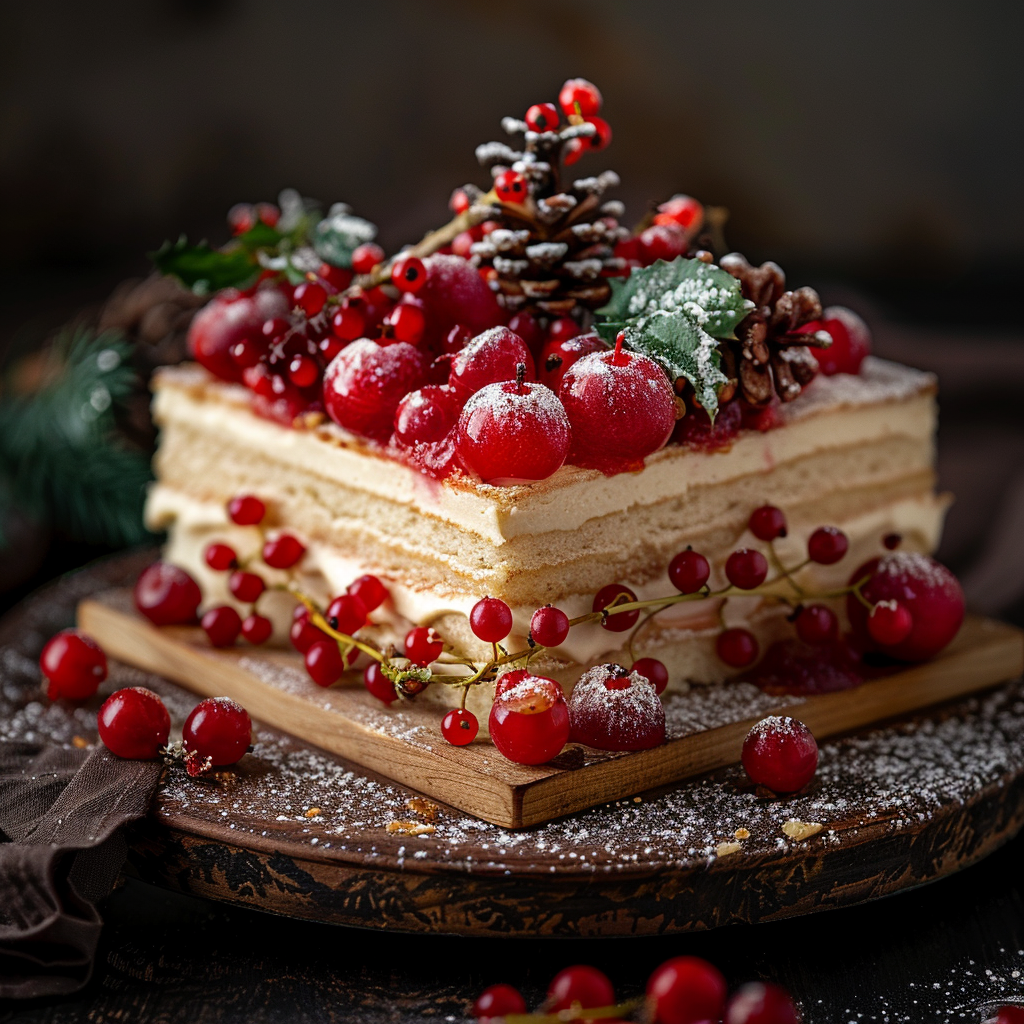
Food photography, especially when snapping pictures of Christmas dishes, relies on texture to breathe life into photos. Depth of field, commonly known as DOF, is a photographer’s secret weapon for making the subject pop against its surrounding elements, showcasing every tiny detail of the food’s texture. A narrow depth of field will focus on the tastiest parts, guaranteeing that the viewer’s eyes zero in on those sharp, mouth-watering elements.
How Depth of Field Brings Out Texture
Photographers adjust their camera’s aperture to control depth of field. A larger aperture (meaning a smaller f-stop number) leads to a narrower depth of field, putting only a slice of the picture in clear focus. This can make the shiny coating on a Christmas ham or the sugary sprinkle on mince pies stand out. But, if you want to capture everything—from the turkey to the tinsel—a smaller aperture (a larger f-stop number) works better, keeping more of your feast in view.
Manipulating DOF helps photographers direct where people look in an image. By shifting between clarity and blur, they create images that let you almost touch the textures – super important for effective food photography. Mastering this technique not just catches the eye but tickles other senses too.
If you’re aiming to weave a captivating tale with Christmas dishes, it’s not enough to just point and shoot. It’s about bottling up the holiday cheer in a photo through well-arranged Christmas goods that spin a yarn. Whether it portrays old-school classics or gives a new spin on festive favorites, your setup can plunge viewers into a holiday narrative.
Capturing Christmas Spirit in Photos
We photographers get to trap the Christmas spirit in our work. It’s crucial to stir up those fuzzy, warm holiday vibes in our shots. We can pull this off by tossing in festive decors, bathing our subjects in natural light for that snug feel, or laying out dishes to flaunt their holiday hues and surfaces.
Creating a Powerful Scene Beyond the Camera
Don’t forget context when you’re setting up a scene. Cranberries, pinecones, and candles can heavily influence what your photo narrates. These details invite the viewer to imagine joining a lovely dinner with close ones.
Mixing Tradition and Innovation
Win over your viewers by blending classic touches with innovative twists. Try building a gingerbread village instead of a single house, or serve the Christmas turkey differently. It’s all about keeping it familiar yet refreshing and fun.
True-to-Life Scenes Embrace the Flaws
Perfection often hides inside imperfections. An askew napkin or a nibbled biscuit makes a setting seem real and relatable. It shows there’s more to the pretty picture: real moments of joy and laughter. Never shy away from such quirks; they add depth to your story.
A Visual Feast: Layout and Colors
Good composition and bold colors can turn straightforward dishes into eye candy. The quintessential Christmas reds and greens are key players, but so are the patterns and fabrics under your food. Arrange these thoughtfully to draw the viewer’s eye through the photo, making every part contribute to your mouthwatering tale.
Crafting Stories with Christmas Food Images
In the end, storytelling via Christmas food photography is an art that thrives on elaborate scenes and emotional connect. A sprinkle of creativity mixed with holiday tradition bakes up stories that are meant to be shared wide – capturing not just edibles but also the festive spirit we hold dear.
Using Props and Backgrounds in Christmas Food Photography
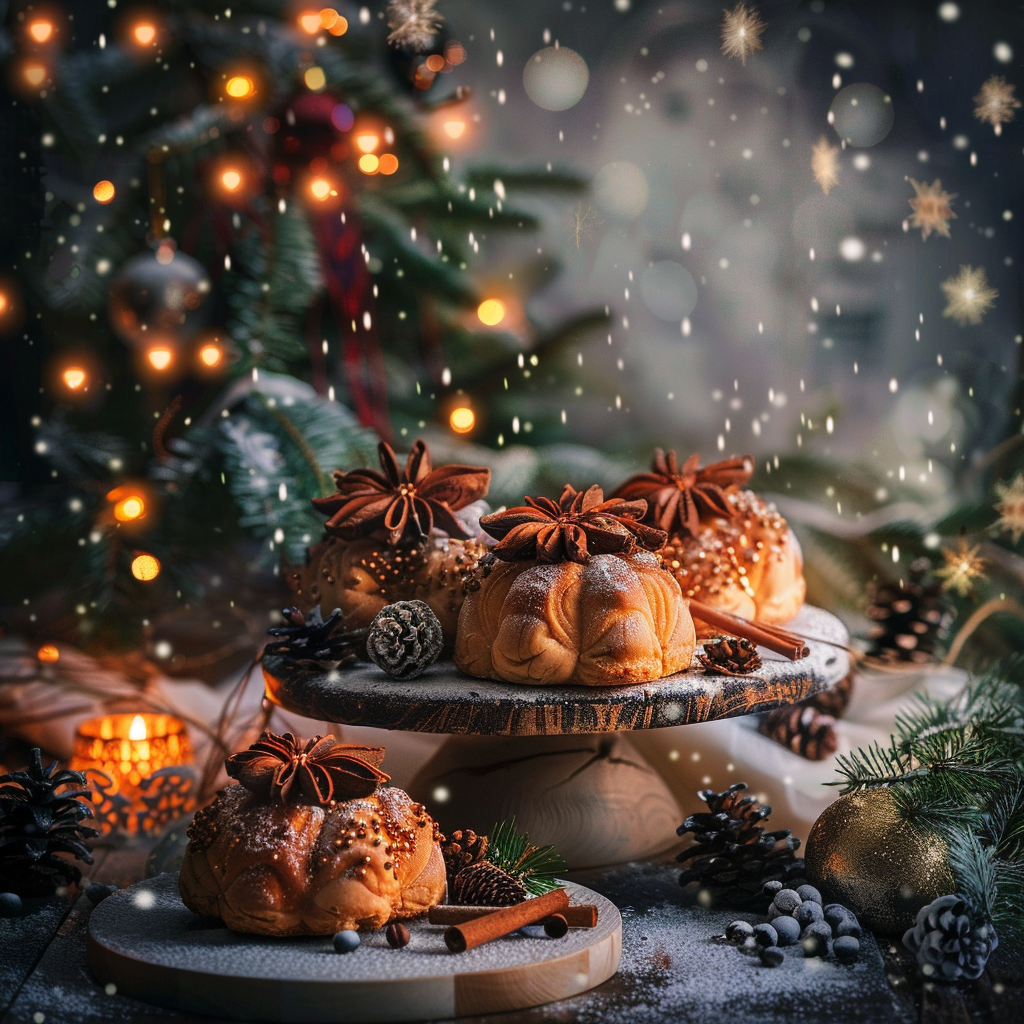
To get that perfect Christmas vibe in your food photos, it’s about a lot more than just taking a pic of some tasty grub. Picking the right props and backgrounds can tell the joyful Christmas tales without any words needed. They’re your tools for setting up the scene to bring out all the coziness, fond memories, and party vibes we all love about the holidays.
Conveying Holiday Stories with Props
Props are super important when you’re trying to make your Christmas food pics pop. They fill up the space nicely and make sure people are looking at what matters – the food. So, here’s what to do:
- Pick stuff that screams Christmas like pinecones, shiny baubles, or twinkly candles.
- Throw in some cooking tools that you might’ve used to whip up the dish so it feels real.
- Go for bold colors – think reds, greens, and golds to boost that holiday spirit.
- Mix in some nature with things like holly or mistletoe to add a bit of texture.
Selecting the Right Backgrounds
Your photo’s backdrop has got a big job. It should make your food stand out, not swamp it. Pick a background that:
- Fits in with your food’s colors and holiday vibes.
- Could be cozy fabrics or an old wooden board for that winter-cottage kind of look.
- Maybe adds a hint of sparkle or Xmas patterns to nod at those twinkling festive lights.
- Stays simple, without any mess or fuss to keep from stealing the spotlight.
Working with textures and layers between your props and backgrounds can really tell the story better in your pics. Tie these bits and pieces together with care, and your photos will shout holiday feasts, fun get-togethers, and good old Christmas joy.
Getting to Grips with Christmas Food Photography
In the world of photography, snapping Christmas meals is key during the festive period. Whether we’re talking about well-loved traditional recipes or exciting new twists on holiday favorites, these dishes steal the show. They’re not just mouthwatering; they also carry a lot of cultural significance.
The Importance of Old vs. New Christmas Recipes
Traditional and new Christmas recipes show how our eating habits have changed over time. Old-fashioned meals like roast turkey and mince pies have been around for ages and are tied to family history. They bring back memories and comfort, keeping us connected to past celebrations.
On the flip side, fresh takes on old recipes or foreign-inspired treats represent our willingness to try new things and embrace different cultures during the holidays.
For photographers, shooting classic dishes means staying true to what people expect to see. But, when taking pictures of modern treats, there’s more freedom to be creative and make something unique that still feels like Christmas.
Mixing photos of old-school and modern dishes tells a story that respects age-old traditions but is also open to change. It’s this kind of compelling storytelling through images that gets people excited about exploring all types of festive foods.
Editin’ food pics is part of the magic, turning decent snaps into glorious ones that scream “Christmas!” Let’s talk about the software that can help with this.
Polishing Photos with Software
For those lookin’ to buff up their Christmas food shots, tools like Adobe Photoshop, Lightroom, and Capture One come loaded with options. Fine-tune the lighting, get those colors right, or clean up any hiccups in your picture. Here’s the lowdown:
- Brightness and Contrast: Dial the brightness up or down to get the lighting spot on. Playing around with contrast will help highlight different aspects of your dish.
- Saturation: Adjusting saturation can really make or break the vibrant look of your photo. It’s especially good for accentuating the reds and greens in Christmas snaps.
- Sharpness: Getting sharpness right brings out textures, making everything from cookies to puddings look more tempting.
Cropping helps frame your food perfectly, while effects like vignettes or filters bring a special vibe to your photo. Remember, the goal isn’t to fake it but to give the real deal some extra oomph. Just a little editing can do wonders compared to going overboard.
To wrap things up, with these tools in your belt, you can cook up images that truly embody the holiday spirit. Just keep it light with the edits, and you’re golden. Subtlety should always be your go-to approach for editing those festive shots.
How to Keep Edited Food Photos Looking Natural

Taking pictures of Christmas meals and making them still look enticing after editing is key. Here’s how to keep their natural charm in pictures.
Keeping Colors True to Life
Getting the colors right in food pics is super important. You gotta get whites just right and adjust how warm or cool the photo is so it matches what we actually see. Don’t go overboard with color; keep it real so folks want to dig in.
Go Easy on Filters and Special Effects
Though filters can be cool, they often mess with the food’s real colors. Best to go easy on them or skip ’em to keep the food’s look on point, texture and all, which makes it look tasty.
Sharpening Just Enough
A bit of sharpening can make a photo pop, but too much? Not good. It adds grit and looks fake. Light sharpening is the way to go for keeping pics clear but believable.
Gentle Retouching
Fixin’ small mistakes is fine but keep it simple. You want your dish to look like it came from a kitchen, not a lab. Going too far makes the grub look weird and not so yummy.
Show off Natural Textures
The roughness or softness of foods gets our mouths watering. When you’re tweaking your pics, make sure these textures stick out, but don’t blow ’em up too big—that’s a no-no.
Find the Right Light and Dark Balance
Playing with light and shadows gives food photos some oomph, but too much can ruin it. It can make your pic look dull or too harsh. Stick with mild tweaks to keep the food’s real shape and feel.
To wrap it up, when you’re messing with photos of holiday feasts, keep a light hand and watch the details. These tricks will make sure your pics add to the yum factor instead of taking away.
Keeping Christmas Dishes Real After Editing
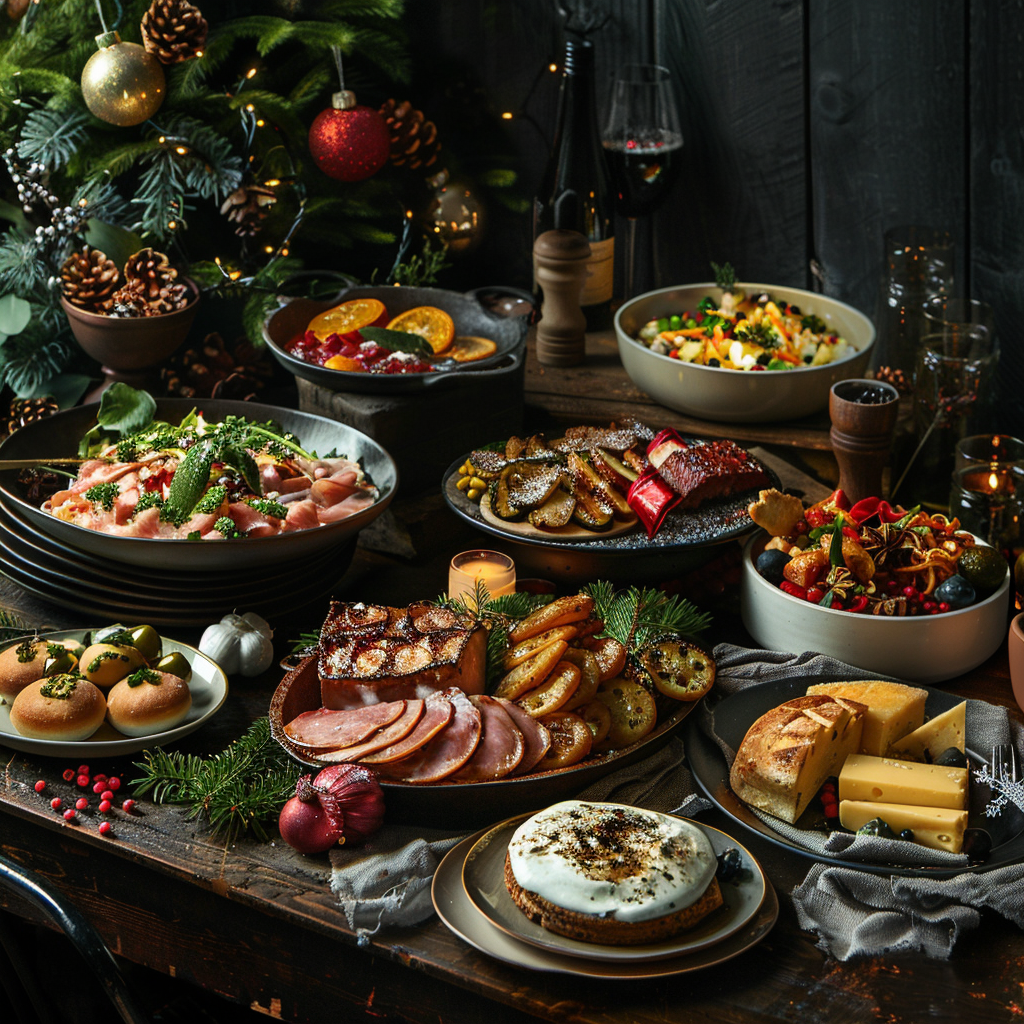
It’s crucial to make sure that Christmas foods look like they do in real life when you take pictures of them. This means making small, careful changes after you’ve taken the photo to improve the dish without changing how it really looks. Be mindful when editing so that the holiday dishes keep their true colors and texture, but still look good enough to eat on camera.
How to Keep Your Food Photos Genuine
After you take a picture, you need to do a few things to make sure your food photos stay true to life:
- Getting the Colors Right: Play around with the white balance and how bright the colors are so that they show off the dish’s real hues without being too much.
- Making it Bright: Change the light levels in the photo so that the dish looks as inviting as if it were under natural light.
- Bringing Out Details: Use a bit of sharpening to highlight details like icing or pie crust but keep it looking natural.
- Cleaning Up the Background: If something in the background is taking away from the dish, tone it down or get rid of it.
All these tweaks need a gentle touch. The goal is to catch the warm, festive vibe of Christmas meals so that the pictures look real and yummy.
Don’t Go Overboard with Editing
It’s just as important not to edit too much. Editing software lets you change a lot, but to keep the dishes looking real, you need to know when to stop. A picture that’s been edited too much can end up looking bad and fake, which is not what you want.
In short, taking pictures of food during the holidays is about keeping things real in your shots. When you edit carefully, you respect the food and the holiday cheer. A well-edited Christmas dish should make someone feel like they could actually grab a bite from their screen – showing you’ve done a great job.
Cultural Importance of Christmas Eats
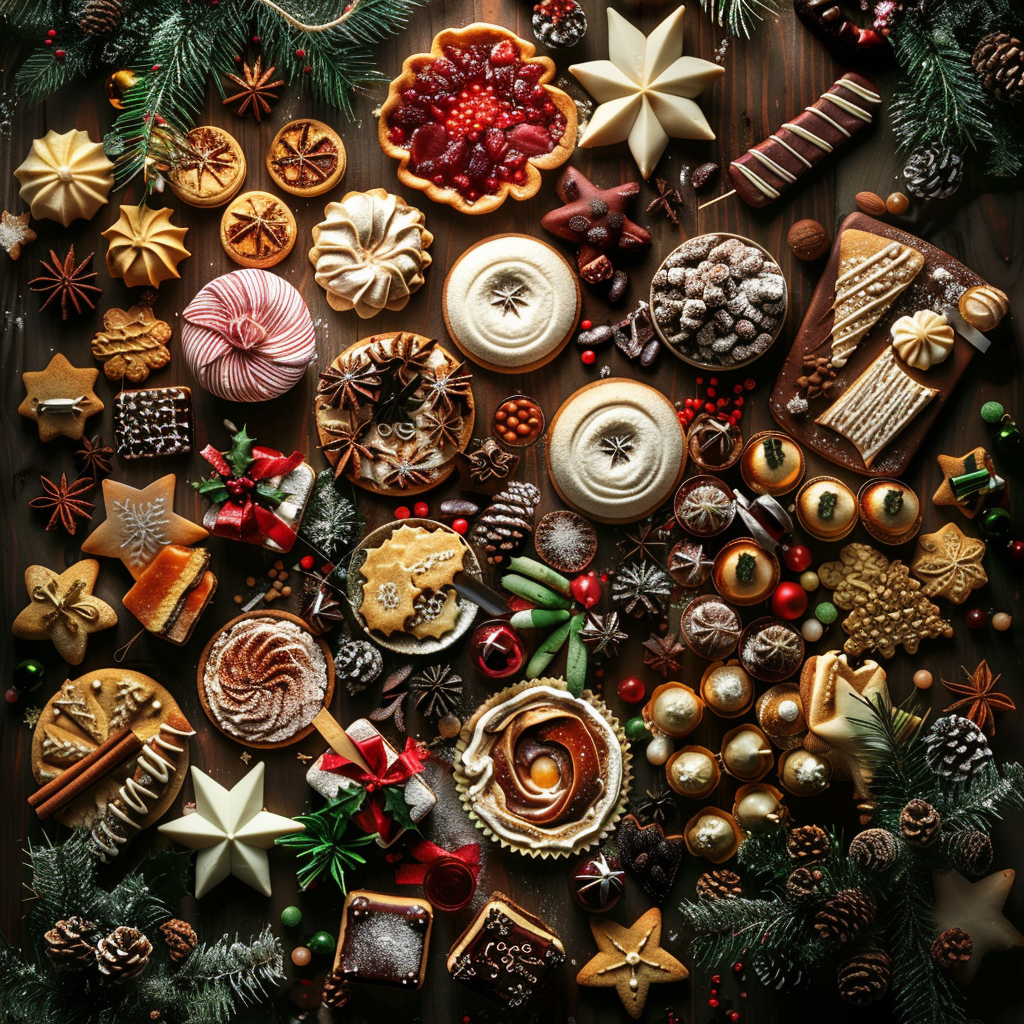
The holidays put a spotlight on food, with Christmas at the top when we talk about festive feasts. It’s all about dishes that are packed with history, happy memories, and bring people together. These foods mean more than just filling up; they’re symbols of culture. Each place has its own Christmas favorites that tell a story of past harvests, faith, and family ways. Picture the sweet smell of gingerbread houses or the rich taste of roast meat: these treats paint a picture of a community’s past and the good times they’ve shared.
Different Ways to Show Off Christmas Treats
Christmas treats come out in all sorts of styles, shaped by local customs and what’s around to cook with. How they look might be simple and heartwarming or sleek and fancy, but they’re always colorful and full of different textures—great for taking pictures. Dressing up the table with candles, holiday decor, and fancy touches makes the food not just yummy but also a treat for the eyes.
Regional Twists on Christmas Food in Pictures
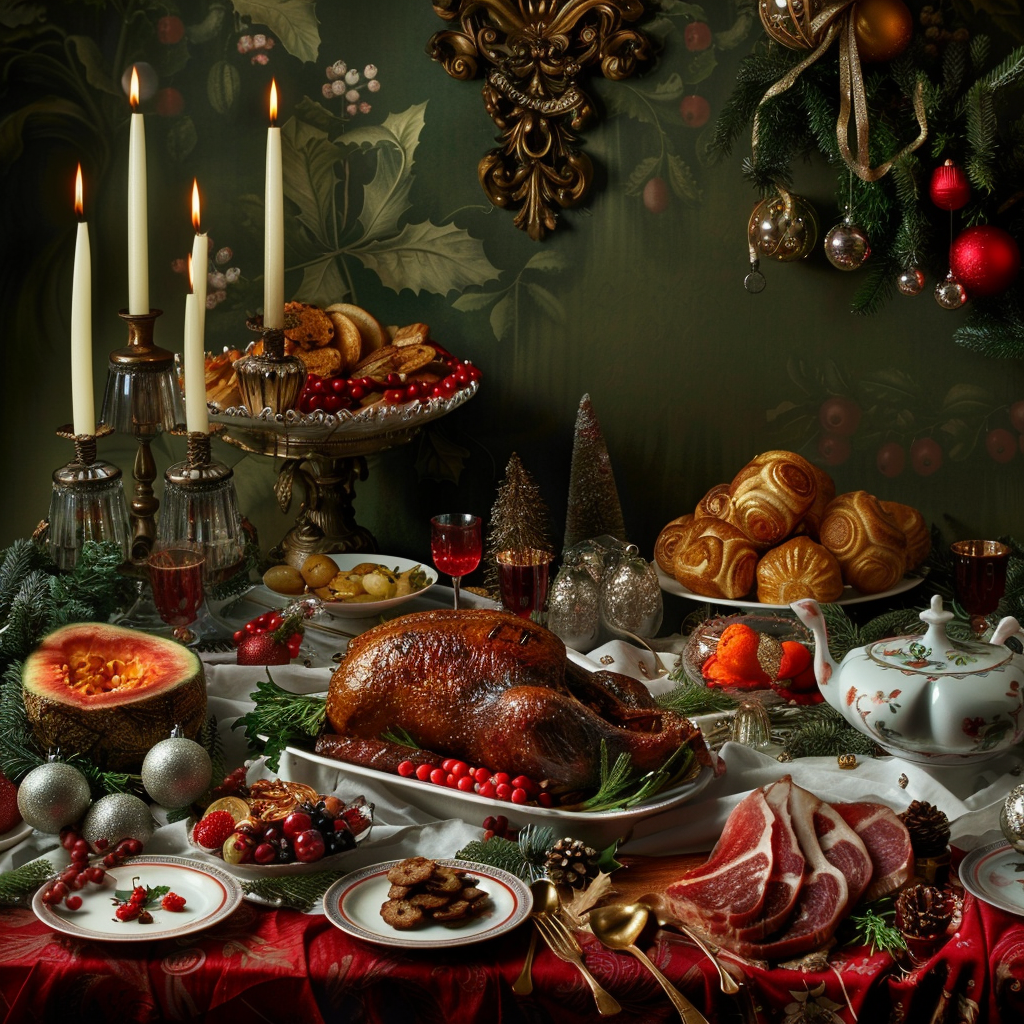
The different local flavors of Christmas meals become especially clear in photographs. In the Nordic regions, you might see sophisticated seafood dishes as the main attraction, while over in North America, a roasted turkey often takes center stage. In Spain, tables are likely to have lots of seafood and marzipan treats, which is quite different from Britain’s preference for pudding and mince pies. Each place brings something special to the Christmas feast, leading to a diverse mix of holiday foods. When these dishes are photographed, the pictures don’t just make your mouth water; they also tell stories about both cultural differences and togetherness during the festive period.
The Importance of Culture in Christmas Food Photos
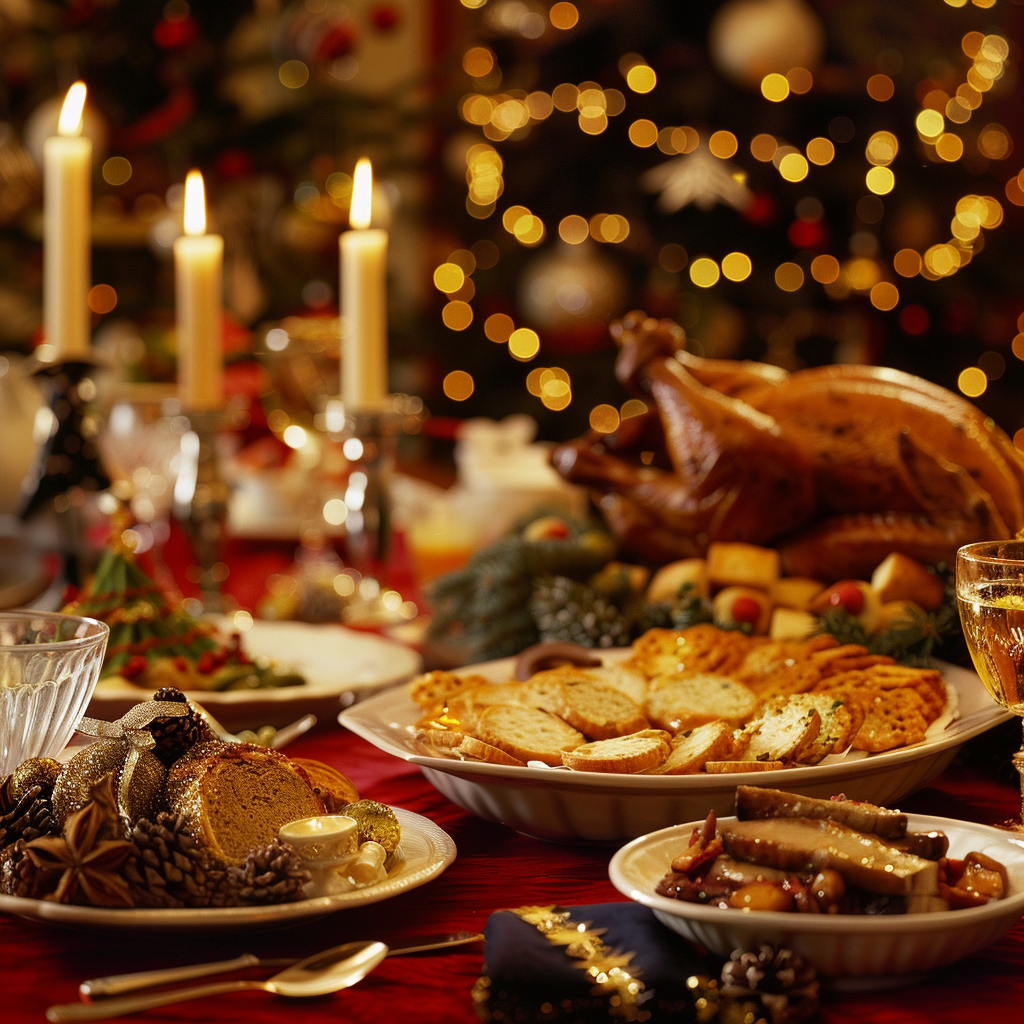
The importance of culture is central to how we take pictures of Christmas dinners. What people in a community value affects both the food they serve and the way it looks in photos. Different cultures have their own ways of celebrating Christmas, and this shows up in the variety of festive foods seen in pictures. Photographers try to capture the spirit of these cultural celebrations in their images, making them more genuine and meaningful.
Capturing Tradition in Pictures
Taking photos of Christmas dishes is about more than looking nice; it tells a story about family history and habits. The background and decorations in these pictures reflect the traditions of that culture’s Christmas. So whether it’s a British roast dinner or a colorful Caribbean fruitcake, each part has its own importance.
Setting the Right Atmosphere
The feeling of Christmas food photos is heavily affected by culture. An Italian Christmas Eve table lit by candles with plenty of seafood looks and feels different from a Finnish display with a bright ham and cold sides for Joulu. This not only changes what’s in the photo but also the vibe it gives off.
Keeping It Real with Details
Photographers pay attention to little things that show off a culture’s real Christmas traditions. The way they sprinkle herbs or arrange food on the plate can reveal where the tradition comes from. For example, the detailed icing on a gingerbread house suggests Nordic styles, while oliebollen with sugar on top might make you think of Dutch New Year celebrations connected with Christmas.
Local Ingredients and How They’re Made
The ingredients themselves tell stories about where they’re from, which changes how photographers decide to show them. Photos might highlight the shiny skin of an American fried turkey or the neat look of Japanese New Year’s dishes. How these foods are prepared and where they’re from become key features in their photos.
Capturing the Spirit of the Holidays
Most of all, Christmas food photos filled with cultural meaning are meant to bring out the holiday feeling. The goal is to capture a magical sense of happiness, togetherness, and celebration that goes beyond just the meal. While photo techniques might be different all over the world—from simple to fancy—the main idea is to create feelings of warmth and friendship with pictures full of holiday joy.
How to Take Photos of Christmas Food
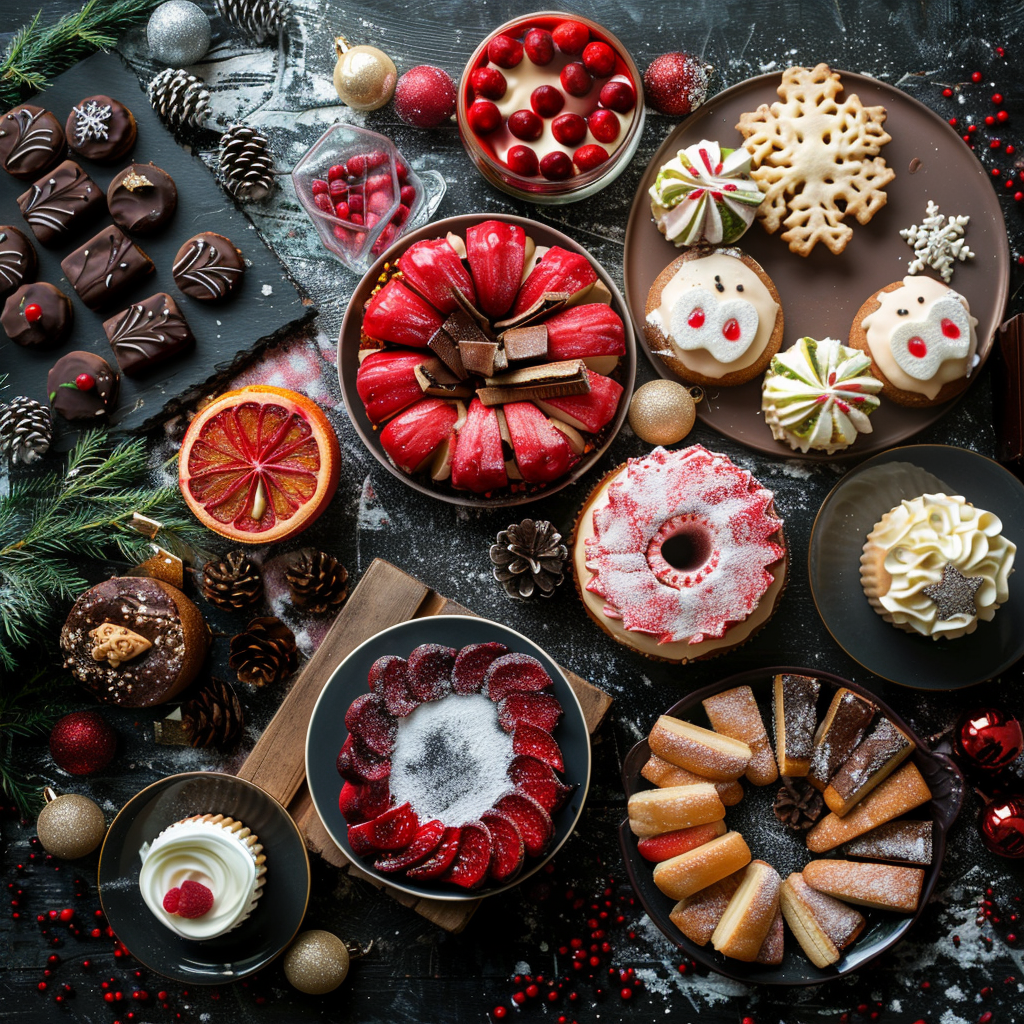
Photographers need to adjust their techniques for taking pictures of Christmas food. This means paying attention to each dish’s unique features and the traditions behind them.
Lighting Tricks for Better Texture
Christmas treats each have their own textures that look good in photos. To show these off, lighting needs to be adjusted. Soft light can make a pie crust look flaky while a strong light might show off a ham’s glaze. Try using natural light or reflectors to get the light just right.
Adding Holiday Decor to Food Photos
Putting Christmas decorations in food photos can set the mood. But don’t let them take attention away from the dish. Experiment with placing desserts to the side or zooming in on a hot drink to give off a cozy vibe.
Picking Colors That Go With Meals
The colors in Christmas dishes are usually warm. Change your camera settings to make these colors look better—this might mean turning up the color or adjusting the light balance to feel more homey.
Keeping Food Presentation Classic
Some food should look traditional in photos, like a neat slice of fruitcake. But sometimes it’s cool to take action shots, like pouring sauce on dessert!
Showcasing Different Traditions
Christmas food is different around the world, and it’s important to respect those differences. Do some research so you know whether you’re snapping an Italian feast or a British roast. You’ll need different strategies for their textures, colors, and how they’re plated.
It’s important to be open, creative, and understand the importance of the food’s culture. Make your photos tell a story that puts Christmas food at the center of the holiday festivities.
When the holidays are near, there’s a big demand for good pictures of Christmas food. This comes from ad companies, food magazines, cookbook publishers, and bloggers who want to make their readers excited about holiday treats. The images you see of a perfect Christmas dinner or a pie coming out of the oven were carefully made by photographers who know their stuff. Their job is important because great photos make people want to try recipes and buy products.
Why Good Christmas Food Photos Matter
The holiday season is a time when brands and bloggers can really connect with people, and great pictures of Christmas food help do this. They sell a feeling of happiness and closeness that’s part of the holiday spirit. Photographers in this area need to be able to make food look its best and capture what Christmas is all about. They have to keep up with trends and deliver quality work even when everything’s hectic around the holidays.
Building a Festive Food Photography Portfolio
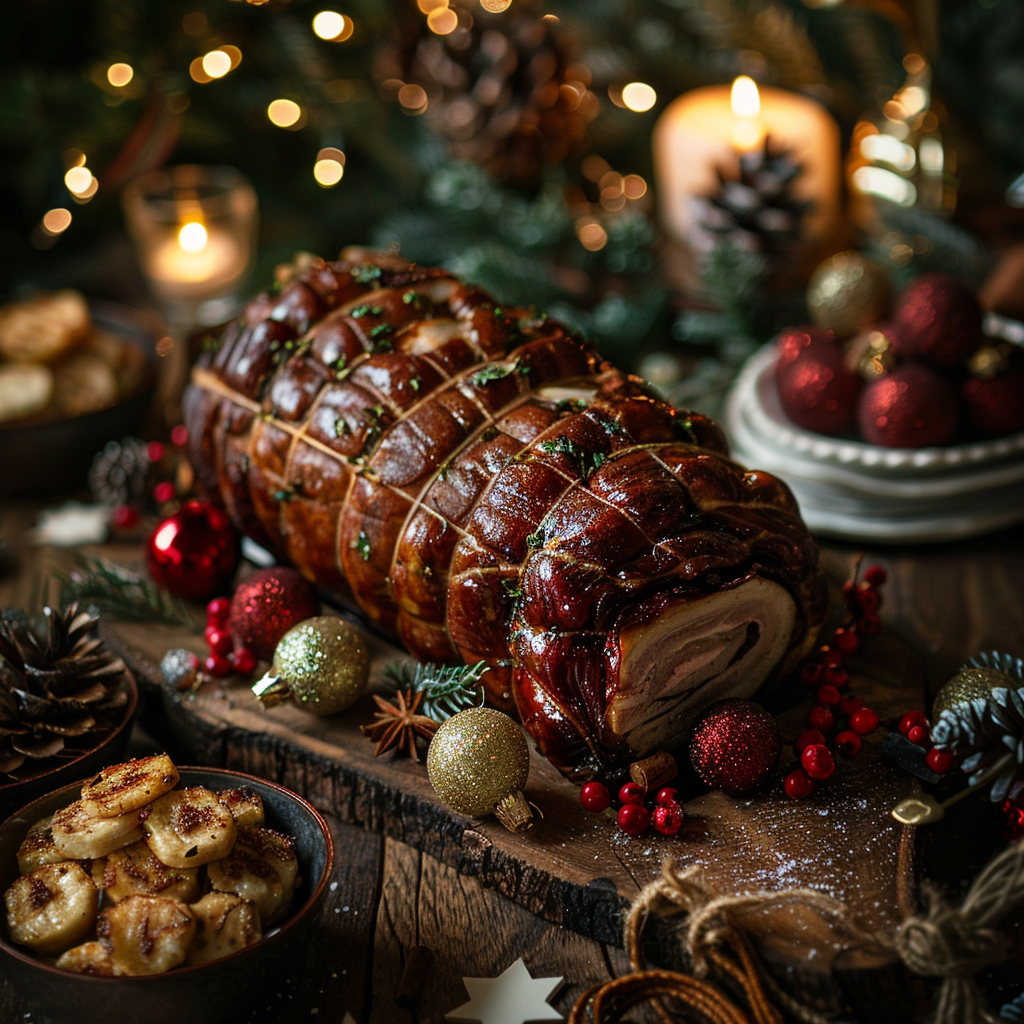
If you’re into photography, having a great portfolio is your ticket to showing off what you can do. This is especially true with Christmas food photos. A portfolio jam-packed with festive treats isn’t just eye candy; it shows you’re creative and flexible – something future clients or partners will dig. Here’s how to put together a spread that screams holiday cheer.
Understanding Your Subject
Christmas dishes look awesome because of their textures, colors, and how they’re set up on the plate. From the shiny coat on a ham to the fancy frosting on cookies, every detail is a chance for you to show off your photo skills.
Selecting the Right Gear
Pick out tools that are good in low light and great for capturing details. A top-notch lens is key for nailing those close-ups of sugary sparkles, deep red berries, and everything else that makes Christmas food pop.
Styling Your Shots
Set up shots that bring out the cozy and plentiful vibe of Christmas eats. Toss in some holiday decor but don’t let it steal the spotlight from your main star – the food.
Lighting Techniques
Use lighting that makes your dish look its best. This could be soft daylight or special artifical lights that really help show off the texture and shape.
Capturing Authenticity
Aim for realness in your photos. Like, snapping a pic of steam floating up from a hot plate or catching the cozy feel of a dinner scene in action. That genuine touch speaks to people.
Editing with a Light Touch
When you edit, make things better but keep ’em looking real. Too much editing can ruin the yummy details you want everyone to see.
Telling a Story
Line up your photos so they spill out a story about holiday feasts. You want folks to feel like they’re stepping into a Christmas flavor wonderland.
Niche Specialization
Think about zooming in on something specific, like only shooting Christmas bakery items, traditional meals from other cultures, or plant-based holiday dishes.
Sharing Your Work
Show off your work like a pro, whether it’s printed or online. Find places where pictures shine – Instagram or your own site – and reel people in with your holiday scenes.
Making Connections
Get chummy with peeps in the biz who get excited about special portfolios. Hit up food mags, diners, or meal stylists who might need someone with your angle on Christmas chow.
Continuous Learning
Keep up with new trends in styling and snapping pics of grub. Tweak and polish your portfolio so it stays cool and catches eyes.
Taking killer shots of Christmas eats is more than just clicking away. It’s an art form that takes smarts and a bit of whimsy. When you build a solid portfolio that tells a holiday tale and captures all that seasonal magic, you invite viewers to dive into December feasts through your eye. Messing up here and there—like an overdone pic or a spoon outta place—is part of the game. Keep at it, and before long, your Christmas food photo book will show everyone just how much you rock this gig.
Networking and Collaboration Strategies
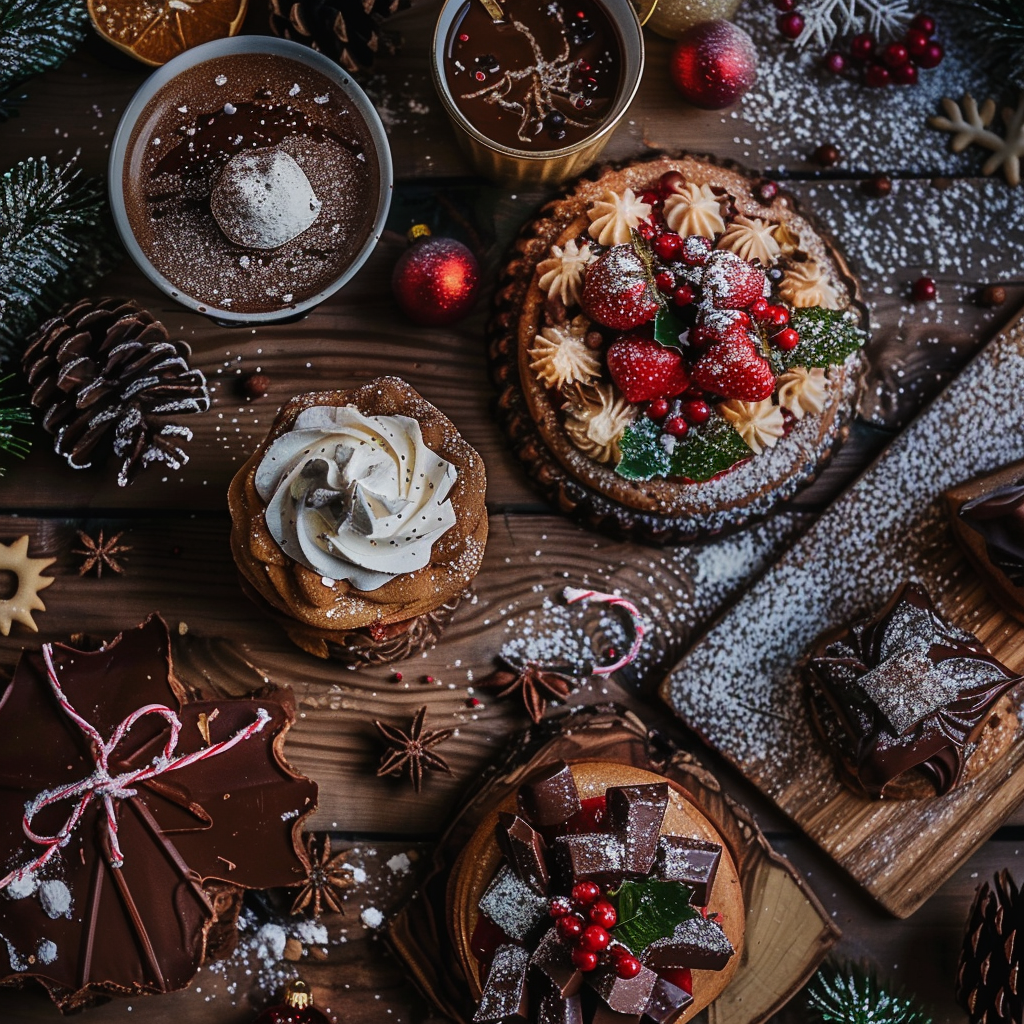
During the holidays, photographers focusing on Christmas food have a great chance to network and work together with food companies and lifestyle mags. These businesses are usually searching for eye-catching images for their holiday articles so its a perfect moment to make contact. Networking can create win-win partnerships, more visibility, and could lead to lasting ties.
Building Connections with Food Brands
For photographers, teaming up with food brands during the holidays can really raise their profile. Here’s the best way to do that:
- Look for brands that match your photo style and offer to create unique images for their holiday campaigns.
- Go to industry events or Christmas markets where you can chat face-to-face with brand reps and get to know them better.
- Be active on social media, show off your photos and tag brands that might want to collaborate, but make sure your work fits with their products.
Making Partnerships with Magazines
Magazines are also a prime spot for Christmas food photographers to showcase their work. To partner up with magazines, try this:
- Create an awesome portfolio of your holiday photos and pitch it to magazine editors, telling them how your pictures can boost their holiday issues.
- Suggest exclusive stories or offer to add your photos to articles they’re already working on, making them pop with holiday spirit.
- Don’t just aim for the big-name magazines; smaller local ones can also offer great opportunities to get noticed.
To sum it all up, by making smart moves in networking and finding people to work with, Christmas food photographers can really put themselves out there and start profitable new relationships in the food and magazine world over the holiday season.
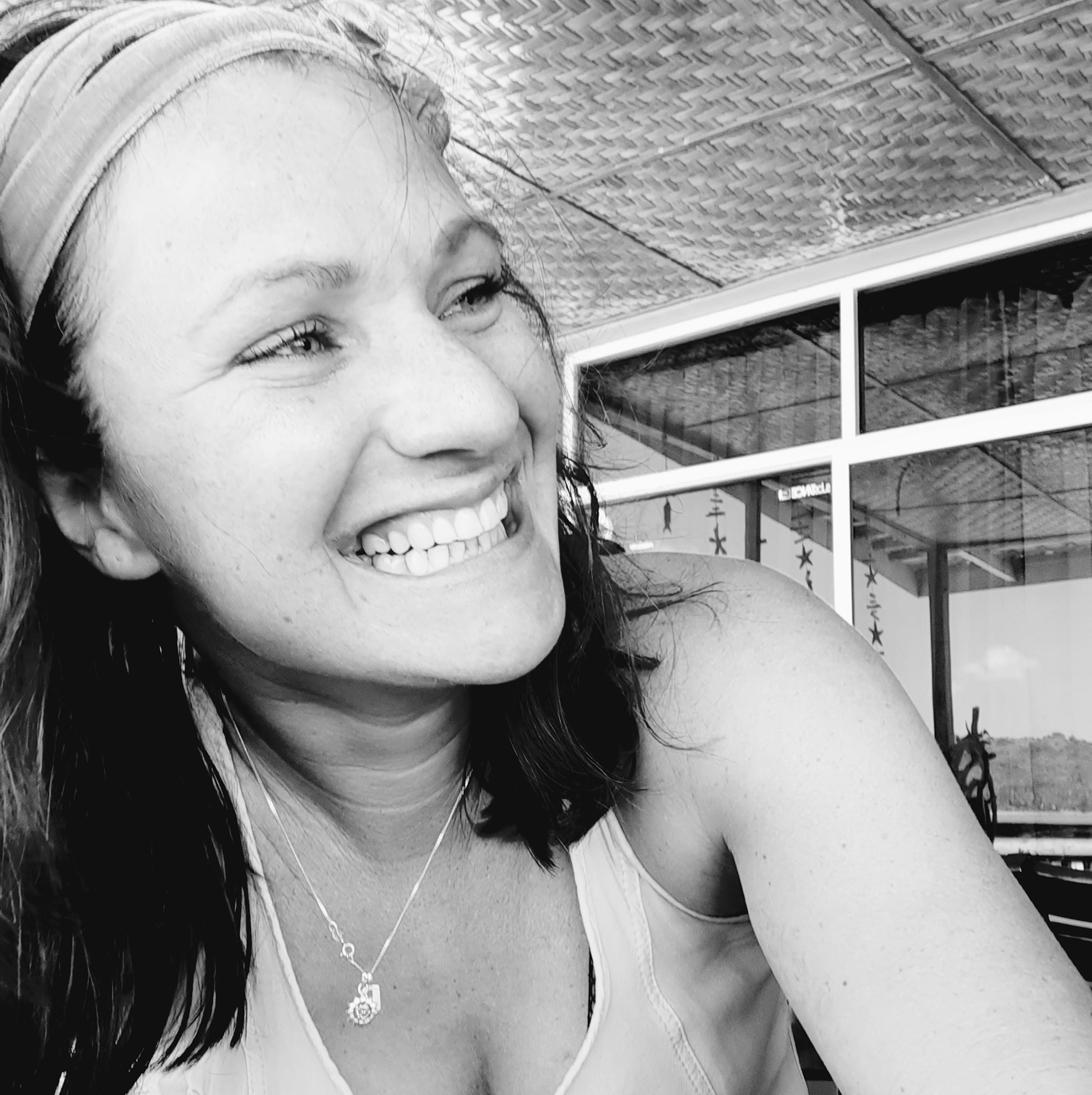
About Author
Rachel Noël is a professional photographer and videographer from the UK with over 10+ years of experience. Rachel specializes in Underwater, Tavel & Portrait photography among other areas.
